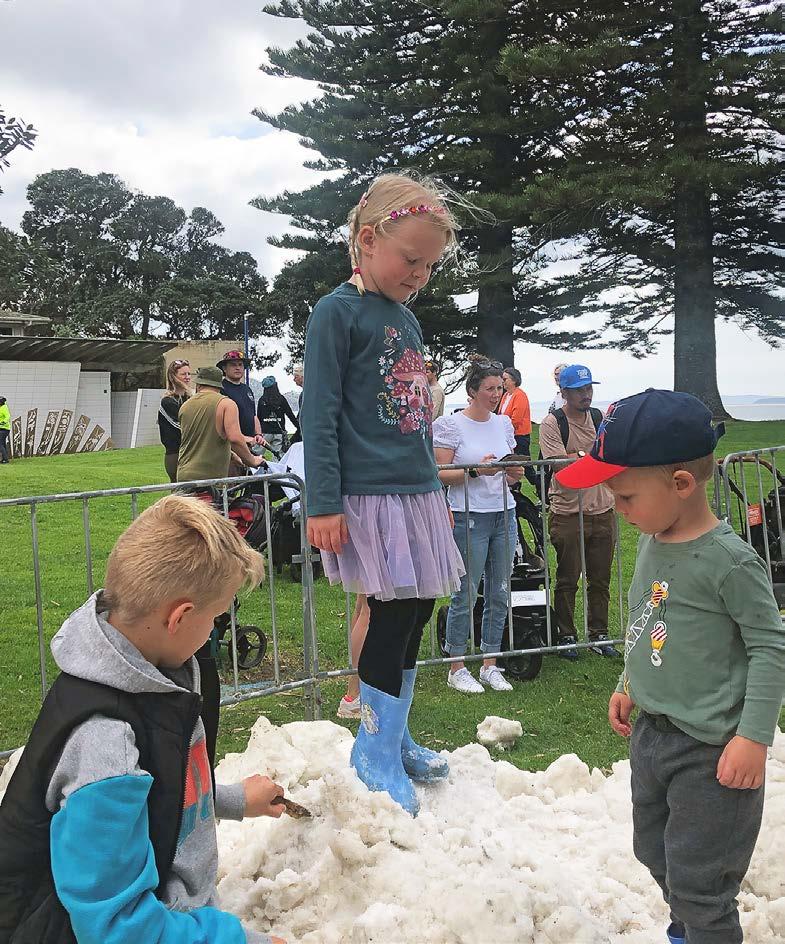October 7, 2024 Troubled bridge over waters ... p3






October 7, 2024 Troubled bridge over waters ... p3





When you hear that a Slipknot-inspired, metal band has won the 14th annual Rockshop Bandquest, you don’t expect to discover they are year 8 students at local Whangaparāoa College.
Charlie (Vocals), Russel (Guitar), Nathan (Bass) and Zhene (Drums) are “Chaotic Blaze”. The band of talented students have taken out the top accolade winning the 2024 competition and picking up a second gong for Killer Guitarist (Russel).
Ever since Whangaparāoa College Head of Music, Sonya Shone encouraged them to
Service specialists for:


enter the competition, the students have had a village of support behind them.
Shone attributes the band’s success to a collaborative effort between the young musicians, their parents, music teachers, and itinerant music staff. All with one thing in common - a passion for music.
Chaotic Blaze picked up $300 for their music department, winning the regional competition at the Bruce Mason Centre before advancing into the national final.
There they won first place, scooping up another $2000 for their music department.
Though the most meaningful part of the win is that Chaotic Blaze get to record their own music video in a professional studio with expert industry level help and guidance.
Run by the team behind Smokefree RockQuest, Bandquest was launched in response to demand for a live music programme focussed on younger students. And this has been the programme’s biggest year yet, with over 300 Primary and Intermediate school bands competing across Aotearoa.
With a love for metal music, the band
took inspiration from the genre for their name and stage personas. It paid off, with one judge sharing, “The masks are genius, love your whole vibe. I can tell you are locked in as a unit, have put hours into your instrument and it shows in your confidence. You took us into your world.”
The winning band was crowned at the RockQuest National finals at Auckland’s Sky City Theatre. Chaotic Blaze’s support crew was there in full force. “We are so excited for Chaotic Blaze and very proud of

21 Florence Ave, Ōrewa, 0931 | ph 09 427 8188


Hibiscusmatters Localmattersnz
issue: October 21, 2024 Book your advertising now
General manager: Jannette Thompson gm@localmatters.co.nz
Editorial: Karalisa Dantas ph 022 019 6569 hibiscusnews@localmatters.co.nz
Patrick Goodenough ph 022 549 8271 news@localmatters.co.nz
Advertising: Angela Gallagher ph 022 029 1895 sellit@localmatters.co.nz
Leigh Cameron ph 022 096 8517 sales@localmatters.co.nz
Graphic design: Lorry McCarthy hibiscus@localmatters.co.nz

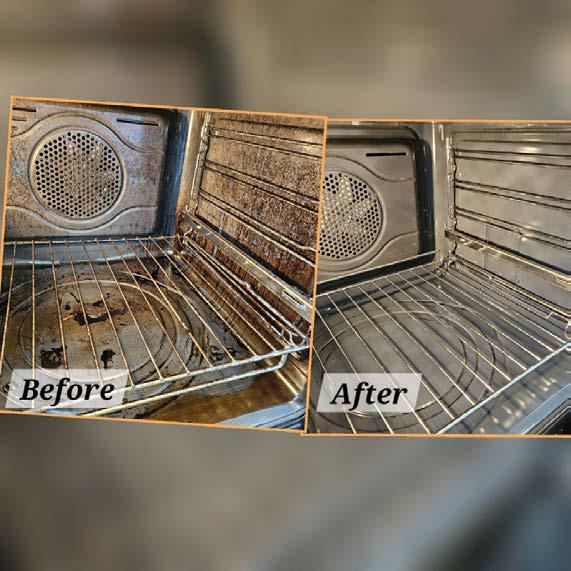

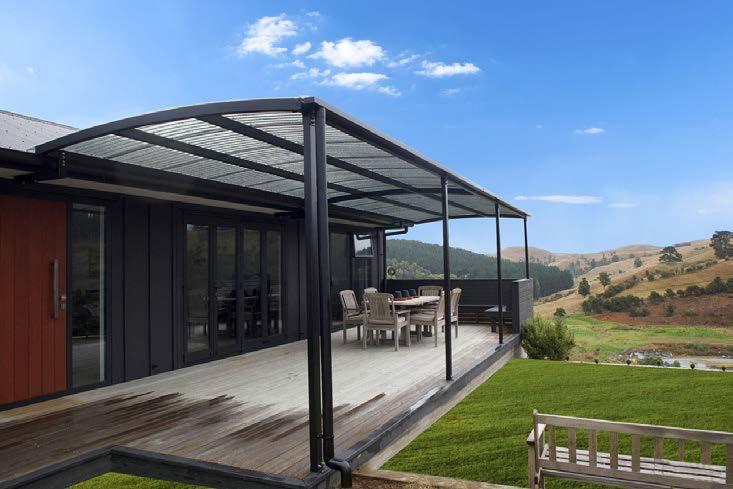
their achievement,” says Shone. “We have a thriving music department and it has now become part of the school culture to enter music competitions.”
Being a part of the BandQuest competition and community has given the students a strong sense of belonging, commitment and musical fulfilment. Bandquest says the kaupapa is to encourage Primary and Intermediate aged musicians onto the stage; learning through experience and developing their performance skills alongside their teamwork, communication, goal-setting and leadership skills.
The win has certainly motivated Chaotic Blaze to follow their passion in the New Zealand music industry – they’re already talking about playing gigs in the future.
From the judges’ comments, it sounds like they’re certainly worth watching out for –“Wow what an electrifying performance. You brought your uniqueness to the stage and took us on your journey. What a privilege to witness such an exceptional young band with an amazing future. Can’t wait to see where you go!”
You could be forgiven for avoiding a visit to the Manly Fairy Garden this year. Until recently, it has been plagued by a foul odour, putting off visitors.
In 2021, Richard and Clare Brown took inspiration from a Hobsonville local Jo Lyes, whose March 2020 lockdown project created a fairy realm. To liven up their view, Brown and his wife began their own fairy garden with native plants. The Browns may have brought the first fairy residents in but it wasn’t long before more fairies moved in to the neighbourhood anonymously.
Last year, Cyclone Gabrielle wreaked havoc on the Manly Fairy Garden. Nestled on a strip of land owned by Auckland Council, the fairies survived but the sloped land beside it didn’t fare as well. There was a slip after which residents noticed the site leaching out sewage and stormwater onto

Great outfits! Good Banter between songs. Insane energy
There’s no better review from a competition judge than them saying they didn’t make notes because they couldn’t stop watching the performance. The young musicians have worked hard to earn the accolades with a strong commitment to regular band practices as well as hours of individual practice. Their dedication showed in their phenomenal musicianship and instrumental technique.
With a proud community of supporters behind them, Chaotic Blaze is already preparing for the next competition –Smokefree RockQuest in 2025.
the street below for the past year.
With the Fairy Garden and beach access at the end of the street attracting young children, residents reported some have slipped or fallen off bikes in the silt left behind. Local residents have been relentless in their pursuit to get the blockages dealt with, sending in photos and videos and lodging numerous complaints. Finally, authorities finished works in the area at the end of September and the Fairy Garden is ready to welcome visitors just in time for its third birthday.
“It looks fabulous – all finished and now hopefully some planting can be done,” a local resident said. The planting is due soon and aims to prevent future slips on the site.
With a week of the school holidays still to go, the Manly fairies would welcome a visit


from children looking to find joy tucked away at the end of this unassuming seaside street.
You can visit the Fairy Garden on Brown Street, Manly. Keep your eyes peeled for it on the right-hand side, as you head to the beach access.
In a bid to bring some cheer to her community, Lyes crafted intricate fairy houses at Onekiritea Park, Bomb Point. Before long Lyes’ had a fairy village, summer light installation, and magical mayoral duties at the “Fairy Works” village. Now, nearly five years on, Lyes is hanging up her wand and the residents of Fairy Works have whisked off into the night. As with all magical realms, it will one day be folklore but the evidence lives on via social media.
Questions about safe access to side roads in Whangaparāoa, impact on retail, and the bus interchange plan, dominated a meeting between the O Mahurangi – Penlink team & Business Whangapāroa.
Initially promoted as a meeting for the public, it was later changed to business only. Business Whangapāroa said the meeting was to ensure clear communication from the Penlink project team to local businesses, following the unexpected announcement of the vital bridge link delay.
The complexity of the Wēiti River Bridge connecting Stillwater and Whangaparāoa was always a key factor in project duration. Then the initial timeline in the tender had to be revised once onsite, due to ground conditions and site access, with challenges including:
Minimising the number of piers (support columns) to ensure a clear waterway below Balancing the West to East incline given the East bank is far higher Bridge height; the deck 45 metres above water level nears that of the Harbour Bridge In between light-hearted comments about starting a Weiti bridge bungy business, local businesses probed the team for clarification on safer access to Cedar Terrace, Scott Road, and Beverly Road. To
Volunteer-led organisation, Supporters of Tiritiri Matangi, has been awarded a Canon Oceania Grant in the Environment category to recognise their positive impact in the community.
Supporters of Tiritiri Matangi is dedicated to protecting and restoring the mauri (lifeforce) of the island in partnership with local Māori iwi and Department of Conservation. The organisation wants to inspire the next generations of conservationists, by creating engaging ecological, cultural, and historical learning opportunities for the thousands of annual visitors to the island.
Canon Oceania research showed a lack of access to technology is holding Kiwis back from major career and life opportunities. The grants programme intends to enhance technological access in New Zealand and supports worthy organisations to further their impact.
Shortlisted from a pool of 600 applications, the Supporters of Tiritiri Matangi have been awarded $5000 to facilitate an educational, community or environmental project that will benefit the New Zealand community.
Dr. Ian Alexander, chair of supporters of
eliminate unsafe right turns, Cedar Terrace will only have left turns in and out.
A key improvement will be the extension of Beverly Road with the entrance further up Whangaparāoa Road from where it currently is, thereby spacing it out from the entrance to the retail precint. There will also be extra lane length on Whangaparāoa Road for vehicles turning into Beverley Road.
The retail precinct entrance on Whangaparāoa Road will remain, also with an extension, and the advantage of two east-bound lanes removing the current issue of all traffic slowing down as vehicles turn in. Disruption to the retail precinct itself is planned to be minimal.
The hotly debated bus interchange on Whangaparāoa Road was also raised as it was unclear from the visualisation whether this was accounted for. Clarification was provided that though out of scope, the interchange does have land allocated. This land returns to Auckland Council for the eventuality that the interchange project is funded.
Also queried was the expansion of State Highway 1. If you’ve been following construction progress, you’ll have also noticed abutments underway for the State Highway 1 and East Coast Road bridges.
The rationale provided for the single span bridge over SH1 is to allow space for lane

This visualisation of the new O Mahurangi / Whangaparāoa Road intersection is an artist’s impression for illustrative purposes only. It may not be complete or fully accurate and should not be used for technical purposes.
expansion in the future but it was made clear that is not in scope of the current project.
Regular stakeholder updates such as this one are within the remit of the O Mahurangi –

Tiritiri Matangi, said, “The Supporters of Tiritiri Matangi are honoured and delighted to be the recipients of the 2024 Canon Oceania Environment grant. This conservation treasure island means so much to many, including our community of mahi aroha volunteers, visiting schools from the Growing Minds programme, wildlife-enthusiasts, adventurers, explorers, scientific researchers,
and visitors from across the globe.”
As a pest-free open sanctuary, Tiritiri Matangi is considered a world-leader of change. The plan for the award ($2,500 cash and $2,500 in Canon product) is to install educational display boards along the walking tracks, so that all visitors can learn of taonga species, and how people can work together to conserve Te Taiao nature.
Penlink project team. Coming up in early November, they will be hosting two dropin sessions for the community to meet the team and learn more about the project.
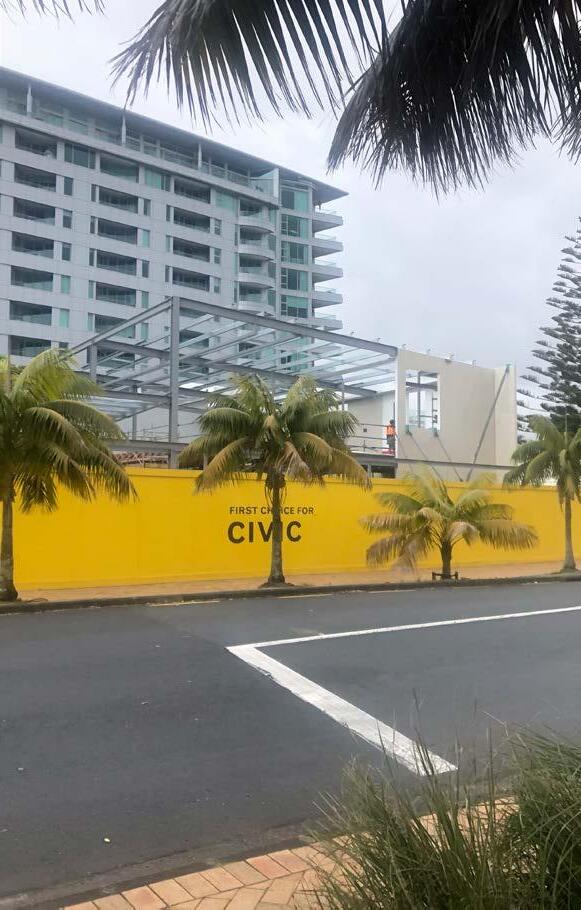
The refurbishment of Ōrewa Library is well underway. If you’ve passed the construction site recently, you will have seen the framing going up. But did you know Ōrewa Library was originally located in front of the community centre they are currently using while the refurbishment takes place?



An opportunity for appeals and objections on subdivision boundary changes in the Rodney Local Board area will open on October 3, following a decision by Auckland Council to accept the recommendations of its Joint Governance Working Party last week.
In a somewhat convoluted process that started in July, council is looking to implement a fairer representation across Rodney by expanding the number of subdivisions from four to five.
Instead of Wellsford (one elected representative), Warkworth (three reps), Kumeū (four reps) and Dairy Flat (one rep), the proposed new subdivisions are Northern Rodney, which is an expanded area based on Wellsford with two elected
representatives, a smaller Warkworth subdivision with two representatives, Dairy Flat (one rep), Kumeū (two reps) and Southern Kaipara (two reps).
The appeals period will close on November 3 when council’s final decision will be forwarded to the Local Government Commission for a decision. The commission will hold a hearing in February with a final determination due by April 11. The new boundaries will then be in place for the Local Government election in October next year.
Council’s Governing Body was told at a preliminary meeting that the new subdivision arrangement would enhance rural representation and spread representation more evenly on a
Rodney councillor Greg Sayers says he wants to get back to the basics following his appointment as chair of Auckland Council’s Budget Committee.
Late last month, Mayor Wayne Brown shook up his committee structure, introducing two new committees and shuffling councillors into new roles.
Sayers was one of several councillors to receive added responsibility.
Brown was the former chair, and Sayers said he appreciated the mayor’s confidence in him to take the lead on a powerful committee.
“I will be maximising the financial transparency and accountability of council’s financial performance for the ratepayer,” Sayers said.
He said it was important to get back to the basics and that spending decisions of elected members, including of local boards, would be consistently challenged.
“Why are elected members voting to spend ratepayers’ money on non-council leisure centre group yoga classes or giving away free haircuts ahead of keeping public rubbish bins in place?”
He noted the council was under extreme financial pressure to cut costs and questioned whether “using public money to fund disc jockeys” was the right thing to do.

I will be maximising the financial transparency and accountability of council’s financial performance for the ratepayer,
He said the Budget Committee would ask the chief executive officer Phil Wilson to make cost savings of $78 million to get greater value for money, which would be the largest cumulative savings since the creation of the Super City.
The committee’s responsibilities include assisting the mayor to develop the 10-year budget and annual budget.
population/member ratio.
Rodney Ward councillor Greg Sayers said he was getting a lot of lobbying from different sectors regarding the 76 per cent of Rodney submitters who didn’t support the changes.
In response, governance principal advisor Warwick McNaughton said there had been 221 individual responses – 20 in support and 76 per cent opposed.
“When you look at the submissions opposed, the majority fall into two camps –one was about the Kaukakapapa area, which we has been addressed in part,” he said.
“The other camp was to do with Warkworth where there was a sense there had been a
degree of mobilisation in the area.
“The nature of the opposition was that they didn’t want to lose representation with a reduction in members from three to two.
“We were getting the message that they thought that the more representatives they had on the board, the more they would be likely to get decisions in their favour.
“I was at pains to point out that the electoral boundaries, wards and subdivisions are a way of spreading representation around. Once elected, members make a declaration to act in the interests of, in this case, the whole of Rodney. The number of members on the local board should not affect whether they get resources or not.”
Following public consultation, Auckland Council has publicly notified its final proposal for representation arrangements across the region ahead of the 2025 local body elections. This means Aucklanders can submit an appeal or objection if they wish, from now until November 3. Councils are required to review their elected representation arrangements at least every six years. This includes reviewing the number of councillors in the Governing Body and the number of members of local boards. The council must also review whether members are elected from the whole area, or by electoral areas such as wards for councillors and subdivisions for local board members. The final proposal amends boundaries and names of subdivisions in the Rodney Local Board area (see story above). It also amends ward boundaries in Central Auckland. In early November, any appeals and objections that have been received will be referred to the Local Government Commission (LGC) to make an independent decision. Aucklanders can expect to hear an outcome on the council’s final proposal by April 2025, allowing time for changes to be introduced before next year’s council elections. Decisions have been made to prioritise communities of interest, resulting in the number of people represented by each elected member in a subdivision area not being within 10 percent of the average for the whole local board area (which is the ideal population-based ratio) including Hibiscus and Bays Local Board. For more details, visit AKhaveyoursay.representation.
By Laura Kvigstad, Auckland Council reporter. Public Interest Journalism funded through NZ On Air.
Gaps relating to alerting and warning infrastructure projects were identified after trialling new technology for tsunami sirens installed in Ōrewa.
The trial is part of Auckland Council’s Tsunami Work Programme including ensuring the region has an effective tsunami warning and alerting network, raising tsunami risk understanding and resilience, and delivering the associated capital and operational works and programming. Questioned about the gaps, council’s principal science advisor Angela Doherty said there was no provision in the current Auckland Unitary Plan for the installation of public warning infrastructure apart from


fire sirens. The council had to come up with “creative ways” to address the gap previously such as installing sirens on buildings. “The options assessment suggests that we need more capital works such as sirens, such as signage, such as investing in a better telecommunications network,” Doherty said. “The provision for alerting infrastructure that creates noise or alerts the public in some other way will be included in the revision of the unitary plan,” Doherty said. With regard to costs associated with the changes, Doherty indicated that this sat with council’s Civil Defence and Emergency Management Committee. “If we have a different approach that would require funding above we would be coming back to the committee to ask for more money but in any case this committee will be the one that decides how that investment will be made.”


Louise Johnston, Dairy Flat Representative, Rodney Local Board deputy chair louise.johnston@aucklandcouncil.govt.nz
As we gear up for summer, seeing so many people out and about, walking the dog, horse riding, or cycling on our rural roads is great. We don’t have footpaths, bridle paths, or cycle lanes in rural Dairy Flat; however, lowering speed limits over the years has made it much safer. This is why I am struggling with this week’s headline, that speed limits are going back up on our rural roads to 80 and 100km/ hr. While at this stage it is still unclear as to what this means for our rural roads in the Dairy Flat subdivision. It does seem an ill-timed switch in Central Government policy, especially given the backdrop of weekly fatalities on our New Zealand roads. While most traffic crashes are due to human error, the outcome will always be determined by speed, and you can’t argue with the laws of physics. Unfortunately, the vulnerable non-motorised road users have been forgotten in the campaign to increase speed on our rural roads. With rural 10-acre blocks being subdivided into increasingly smaller lifestyle blocks and greenfield developments such as Milldale progressing at lightning speed, I think the focus should be reducing congestion rather than spending millions on increasing the speed limits. Congestion in the next few years will get much worse for our area, especially with the push for returning to the office, the thousands of houses to be built in Milldale, and the recent private plan changes lodged with Auckland Council by developers in the Dairy Flat subdivision,
bringing forward greenfield development by more than 20 years. This growth in outof-sequence housing does not come with the funding for upgrades to the Silverdale interchange or new motorway on ramps, and there is no funding for an extension of a dedicated bus lane on the Northern Busway Lane from Albany to Silverdale or for expanding the parking at the Park n Rides. In my view – congestion kills productivity, not safe speed limits!
On a more positive note, if you have yet to visit the 154-hectare park at Green Road in Dairy Flat, you must go. We have enlarged the gravel car park, and work has started on the pathways. There are markers in the park, guiding walkers, horse riders, etc., which are very similar to a DOC trek. While we have secured funding for a toilet and water source, and allocated $620,000 to the pathway connections, there is still so much to do before it is the Cornwall Park of the North Shore. This will be an intergenerational project, and we will need your help! A great group of motivated people who care deeply about the development of Green Road Park have formed an incorporated society, the Green Road Park supporters’ group. Since incorporation in September, they have applied for a grant from the Dairy Flat Community Trust for specimen tree plantings for the park. Please get in contact if you want to learn more or become involved.
Plans to raise the speed limit to 110km/h on the Northern Motorway from Ōrewa to Warkworth were not universally welcomed by Rodney Local Board members at their September meeting. Misgivings were raised in proposed feedback put forward by deputy chair Louise Johnston over additional risks of death and serious injury that could arise from the change, and the fact it would make little difference to travel time. “Such an increase will bring an improvement of average journey times of only one minute and 36 seconds and, given heavy transport vehicles will still be limited to 90km/h, the productivity benefit often spoken of by Ministers and others seems negligible.” However, Geoff Upson, who campaigned on maintaining or increasing speed limits, countered with an amendment to support the increase “noting that the road was built to high safety standards”, which passed with support from Upson, Michelle Carmichael, Tim Holdgate, Colin Smith and Ivan Wagstaff. Johnston, Brent Bailey, Mark Dennis and Guy Wishart voted against.


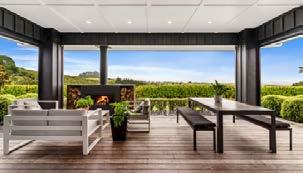





a farewell that reflects your life’s journey. Prearrange your service now to ensure everything unfolds just as you wish.


My husband and I have been cycling the Te Ara Tahuna / Ōrewa Estuary Path for the last 10 years, but recently it has become dangerous. Walkers with pods in their ears don’t hear our bicycle bells. Children riding trikes several metres ahead of their parents don’t hear our bicycle bells. Mothers with prams walking two abreast and chatting don’t hear our bicycle bells. The worst of the lot are people with dogs running free, off-lead. They don’t care where their dogs are. My husband has had two bad injuries on this track. Five years ago, a mother was on her phone while her child rode 10 metres ahead. The child didn’t hear her mother’s instructions and my husband went over his handlebars trying to avoid the girl. three months recovery for a slashed leg injury! This year, two girls were running with their off-lead dog 20 metres ahead of them. You guessed it, the dog ran in front and my husband went over his handlebars causing injuries to his leg and arm. My understanding is that dogs MUST be on a lead! I was taught your dog was to be on your LEFT hand side. NOT with a 10 foot lead allowing him to run where he wants to. The other day I rode by myself as my husband still can’t ride. You guessed it, five dogs running free. I could also have ended up with injury. Do these dog owners know that if they damage my bike they will be paying to get it fixed.
Ronnie Vance, Ōrewa

Hibiscus Matters wishes to extend sincere condolences to the family and friends of Eddie Law. Eddie passed away peacefully, aged 75, on September 23. Eddie was a pillar of the Coast community, and a great supporter of this paper. He was one of the driving forces in setting up the Hibiscus Sea Rescue Trust and Coastguard Hibiscus, where he was made a Life Member and where he remained one of the organisation’s most valued trustees and greatest supporters.
I noticed that Council is killing the grass on the fields again. The grass is brown now. I pass the soccer fields quite often and have noticed over the years that some of those fields get a new surface sort of every year. Why would you do that? When I was a soccer coach some years ago this was never done. The whole thing seems very odd to me. And if they kill the grass there should be a warning or at least a notice on the fields. The playground is just next to one of the fields. Our grandchildren were running barefoot on those fields when I told my daughter-in-law to stop them from doing it. There were many other children. No warning signs on the field. The question is first of all what chemicals do they use to kill the grass? And then of course the second question is why they do that in the first place? When I used to be a coach here, Council would cut the grass and besides that leave the fields alone. Why does Council spend all that money and distribute all that poison on the grass? That cannot be good for anybody. I also sent a message to the Auckland Council but I have not heard from them yet. Hans Geese, Whangaparāoa
Congratulations to Debbie Wood of Red Beach! Debbie, you’ve won our Book Giveaway. Please pop in to collect the first two books of Richard Rowley’s trilogy.
Medicine rollout begins
October 1 marked the first day a range of new medicines, including cancer medicines, became available in hospitals and health centres across the country. This exciting milestone for the four health agencies tasked with ensuring New Zealanders can readily access new and widened medicines as part of the Government’s $604 million investment in medicines over four years. Pharmac, Te Aho o Te Kahu | Cancer Control Agency, Ministry of Health and Health New Zealand | Te Whatu Ora have been working at pace to offer these new, lifechanging medicines to 175,000 New Zealanders. Pharmac CEO, Sarah Fitt, acknowledged the fast work of her team and the invaluable input from health care professionals and the community who have contributed through the consultations to date. “The work to deliver these additional medicines began in June. We’re thrilled to see our team’s efforts translate into better lives for people with cancer and a wide range of other diseases and illnesses.” Dr Diana Sarfati, Director-General of Health, says this is an important milestone in the four-year investment made by the Government. “The health system is pulling together to make sure New Zealanders can access these medicines as quickly as possible. “This is just the beginning of the roll-out and it will take time for the health system to deliver all the medicines, but they will improve the health and life outcomes for thousands of New Zealanders with a range of health conditions.” The rollout is the result of a collaborative effort across a number of agencies, all committed to improving access to medicines and health outcomes for all New Zealanders.
Seniors can travel for free on trains and selected bus and ferry services in Auckland, after 9am on weekdays, and all-day weekends and public holidays with a gold AT HOP card loaded with a SuperGold concession. On Friday 25 October, Auckland Transport (AT) will show seniors how to take the bus from Ōrewa to Hibiscus Coast Station, and then change buses to get to Constellation Station. At Constellation Station they can purchase a gold AT HOP card and get it loaded with SuperGold concessions. What to bring: Blue AT HOP card if you have one. • SuperGold card. • Debit/EFTPOS/credit card, or cash – the gold AT HOP card costs $5 and must be loaded with at least $1 at the time of purchase. • Proof of ID – One of the following: current Passport; current Driver Licence; Card Evidence of Age Document; AT Senior Citizen ID card; AT Total Mobility ID card; Fullers Ferry monthly pass ID card with photo. If you do not have photo ID, you can use any two of the following original documents: Birth Certificate; Marriage Certificate; Deed Poll Certificate. If you want to use one or two of the following other ID documents, these will only be accepted if on the relevant organisation's letterhead and includes your name and address: WINZ document; IRD document; Court-issued document; Council rates bill; Water rates bill; Bank statement; Insurance company letter; Power company bill; Telephone company bill. To register for this fun, informative outing contact Age Concern Rodney 09 426 0916 info@ageconcernrodney.org.nz Group number is limited.

The Dotterels have started breeding and some groups already have nests with eggs .... for the areas which have, as yet, no nests found, vigilance is key. Please keep a sharp eye out for any birds which look to be acting strangely, as this could denote a nest nearby. The school holidays may mean beaches and Parks are extra busy and any eggs/nest could be easily trampled. If you see anything please let us know on the Big Manly and Tindalls Dotterel Group page or advise Jenny by email at j.hanwell@forestandbird.org. nz. They can then act quickly to erect advisory signs and warning boundary lines to inform beachgoers and dog walkers to keep a good distance.


By Laura Kvigstad, Auckland Council reporter. Public Interest Journalism funded through NZ On Air.
Auckland Council’s draft Contributions Policy 2025 aims to recover $2.3 billion over the next decade, to contribute to the council’s infrastructure projects.
“Existing rate payers should not have to actually subsidise future growth investors,” said Mayor Wayne Brown.
A breakdown of funding sources over the next 10 years estimated that for transport investment $3.5 billion would come from rates, $3 billion would come from the government and $900 million would come from Development Contributions.
Brown said developers wanted to ensure they were not paying more than they had
to but that the council needed to protect ratepayers.
“When push comes to shove there’s only three people that can pay: developers, ratepayers or taxpayers. These costs are required for the development to happen,” said Financial Strategy general manager Michael Burns.
The council cannot retroactively charge development contributions so it was important to get it right.
Financial Policy manager Andrew Duncan said, “If we don’t plan for these Investments now and include them in the policy then by that time we might have foregone somewhere between $400 and 600 million of revenue,”
Public consultation on the draft policy will be open until November 15.
By Laura Kvigstad, Auckland Council
The potential for some storm-affected homeowners to have fallen through the cracks has been acknowledged by the Tāmaki Makaurau Recovery Office.
The opportunity for Aucklanders to register for the Auckland Council’s categorisation scheme closed on September 30.
“We are sorting out some rules for ourselves around what discretion might be used to accommodate people who do miss the deadline,” said chief executive officer Phil

Wilson.
Being an opt-in process, means some homeowners may have missed out on getting their property assessed and categorise based on whether there is an ‘intolerable risk to life’ from future storms, and whether there is anything that can be done to reduce the risk.
“We are going to have to be quite firm on that but there will be situations, I have no doubt, where a little bit of latitude and a little bit of discretion needs to be exercised,” said Wilson. Though he makes it clear that discretion might be considered only in very exceptional cases.






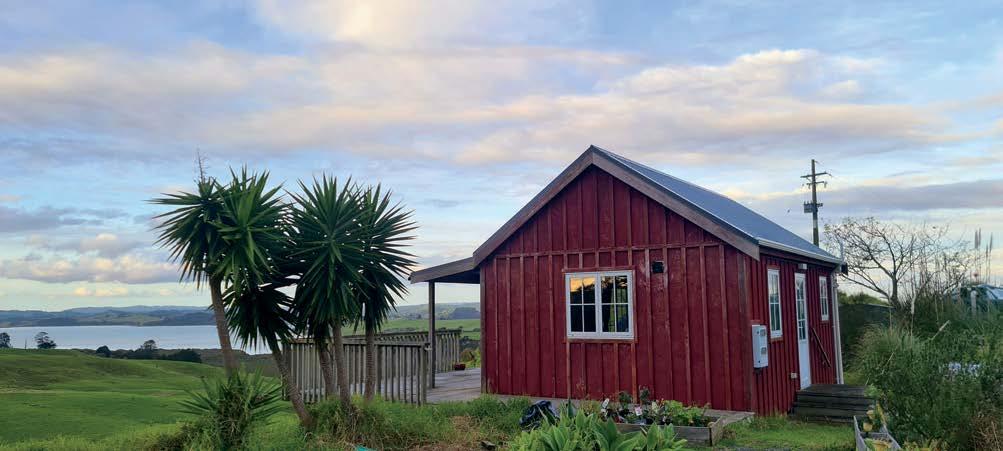





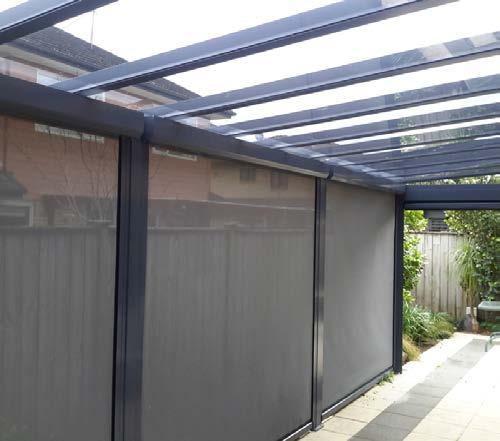
LTD
Servicing Hibiscus Coast & Rodney Garage Doors for 25 years Fast professional Garage Door & Garage Door Opener Repair/Replacement
0800 63 63 48

10/22 Highgate Parkway, Silverdale M: 021 535 367 E: info@garagedoorrepairman.co.nz

Secure your pre-summer install today!

Michael Goudie michael@teandem.co.nz
When you ask business owners about their marketing efforts, many get defensive, scrambling to list off everything they’re doing to attract customers. But here’s the truth – marketing doesn’t always have to be complicated. For some businesses, wordof-mouth and a solid reputation might be all that’s needed to keep things running smoothly.
However, business dynamics can shift, and when they do, marketing becomes more relevant. Whether you’re introducing a new service, expanding your hours, or trying to attract a new audience, understanding your business’s current position in the market is crucial. The first step is taking a good, honest look in the mirror and asking yourself: How do people perceive your business?
Decks | Fences | Pergolas | Balustrades | Louvers | Lighting | Outdoor Furniture | Accessories & more!
Book, quote, measure & install 12 Elizabeth Street, Warkworth www.deckingdirect.nz | 0800 332 546

Are you seen as the premium, higher-cost option, or do customers come to you because you’re affordable and efficient? Are you known as the go-to person for solving problems, or are you still viewed as the newcomer trying to make a name for yourself? All of these perceptions play a key role in how your business is positioned, and they should guide your approach to attracting customers.
It’s important to understand your reputation within the industry because it informs the next steps you take. Some businesses might not need a formal marketing campaign to grow – existing customer satisfaction and strong word-of-mouth may be enough. But for others who are pushing for more
market share, breaking into new product ranges, disrupting a status quo, a marketing strategy is crucial.
For instance, you’ll need to rethink how you engage if your business is trying to reach a different audience than usual –perhaps a younger demographic or people in a new geographic area. This doesn’t mean bombarding people with promotions or flashy ads but rather crafting messages that resonate with that specific group and making sure your business is visible where they spend their time.
A simple change in your offerings or customer base can mean shifting the way you communicate. It may involve revisiting your online presence, adjusting the tone of your messaging, or exploring new channels, like social media or email newsletters, that align with the habits of your target market. Marketing doesn’t have to be overwhelming. It’s less about throwing tactics at the wall to see what sticks and more about being strategic with your actions. The key is understanding your business’s strengths, its perception in the market, and engaging the right audience in a way that makes sense. At the end of the day, it’s about adapting when necessary and staying true to what makes your business unique. By knowing when and how to engage potential customers, you can focus on marketing only when it truly matters – maximising your impact without unnecessary effort.
7, 4 Keith Morris Lane, Ōrewa 09 426 6215 mark.mitchellmp@parliament.govt.nz For assistance please email or call our office



Motorists travelling on the old State Highway 1 through Waiwera have probably noticed a couple of unusual cars sitting beside each other in the roadside parking bay recently.
They don’t belong to freedom campers nor have they been abandoned, rather the red Mini Cooper and yellow Honda Logo are both owned by Billy Leigh 38, a former Warkworth local and Mahurangi College student.
Both vehicles are filled to the brim with everything from vintage televisions and toys to electronics and empty drink cans.
Nearly every inch of space is accounted for, both inside and out.
Two tyres are strapped down to a wooden pallet on the roof of the Honda while a fishing rod is attached to the grill of the Mini, which runs a hose into the radiator to keep the engine cool and “it works pretty well”.
The only room Leigh has for himself is the driver’s seat where he sleeps sitting up.
“I kind of like sleeping weird. I just lean my head on the junk and fall asleep. It’s kind of like a pillow,” says Leigh, famously known as Bilbo in the online community.
A self-described mechanic, welder and
electronics whizz, Leigh spends much of his time tinkering with the many things he’s acquired over the years.
Unfortunately, “$3000 worth of gear” was recently stolen from the Honda including solar panels, tools and other valuable items.
The theft happened after he left both cars unattended on the hill above Wenderholm Regional Park.
“The door to the Honda was shut but the cops have taken my key so I can’t lock it. But the idiot didn’t know that (it was unlocked) so he bent the top half of my door and must have reached in,” he says.
After the break-in Leigh drove the cars down to Waiwera one at a time and is now stranded there.
In the past he’s used the Honda to tow the Mini, which is no mean feat considering Leigh does this by himself using a makeshift towing connection.
“It’s the complete opposite to what you would normally do because the Mini’s actually more powerful. I’ve towed over hills and on gravel roads.”
Ideally, Leigh would like to find a house with some land where he could settle and “have heaps of cars, whiteware and scrap” but “everything is too expensive”.









The flowers are coming out to say hello.
Open days Thursday 17 & Friday 18 October, 10am – 2pm.
Open days Thursday 17 & Friday 18 October, 10am – 2pm.
Why don’t you?
The flowers are coming out to say hello. Why don’t you?
With plenty of gorgeous grounds to enjoy, there’s nothing quite like Arvida’s Peninsula Club at springtime. Join us at our open days and explore the beautiful gardens and properties, while enjoying a cup of tea from our friends at Tea Total and a cupcake (or two, we won’t judge).
With plenty of gorgeous grounds to enjoy, there’s nothing quite like Arvida’s Peninsula Club at springtime. Join us at our open days and explore the beautiful gardens and properties, while enjoying a cup of tea from our friends at Tea Total and a cupcake (or two, we won’t judge).
We’ve got a selection of villas and apartments waiting for you to view. These openings are a rare find, so don’t miss your chance to secure your spot.
We’ve got a selection of villas and apartments waiting for you to view. These openings are a rare find, so don’t miss your chance to secure your spot.
Call Cassandra on 021 371 826 or find out more at arvida.co.nz/peninsulaclub
Call Cassandra on 021 371 826 or find out more at arvida.co.nz/peninsulaclub


Sam Woolford, LegaSea Project Lead
The days are getting longer, the jandals are coming out of hibernation and a cold beer feels that little bit more rewarding. All signs that a Kiwi summer is on its way. For most of us, this means more time on the water, sharing laughs and kai moana with family and friends. But as we get closer to our favourite time of the year, a dreadful reality sets in as some of your favourite spots – Hauturu Little Barrier, Kawau Bay and the Noises will be locked up from fishing, as well as the Mokohinau and Aldermen Islands.
The impression is that these small protected areas will contribute towards restoring the Hauraki Gulf Marine Park. But it’s hard to believe that when the closures don’t address destructive fishing methods, excessive catch limits, land runoff and sedimentation – all factors contributing to the long-term decline in fish abundance and their habitats.
LegaSea and the New Zealand Sport Fishing Council raised these concerns to the Environment Select Committee earlier this year. Despite this, the committee has given the go-ahead to the government to implement the Hauraki Gulf Marine Protection Bill that includes 12 high protection areas (HPAs), five seafloor protection areas and extensions to two existing marine reserves.
It’s encouraging that the new bill promotes the restoration of the precious habitats and fish populations in the gulf. However, the government cannot expect it to reverse decades of damage from overfishing, trawling, dredging, run-off

and sedimentation just by closing some small areas to fishing.
Our oceans are complex and require complex solutions if we want restored abundance. The Hauraki Gulf needs a combination of both marine protection and effective fisheries management tools to bring it back to life. Small closures do not change the total amount of fish harvested, it simply shifts the fishing pressure elsewhere. This is why the government needs to implement fisheries management controls.
Making the Hauraki Gulf a separate fisheries management area alongside the HPAs means catch limits can be adjusted to reflect fish abundance in the gulf.
A combination of area and fisheries controls was initially agreed as the best course of action to revitalise the gulf by environmental, recreational, Māori customary and commercial fishing interests involved in the 2017 Sea Change plan process.
The Hauraki Gulf Marine Protection Bill does not reflect the agreed plan. It’s a fraction of the original deal – a bunch of closures and to top it off, bottom trawling will still be permitted in the majority of the marine park. A rip-off if you ask me.
The health of the Hauraki Gulf is not improving, and establishing more HPAs is not the complete answer. The definition of insanity is doing the same thing over and over again and expecting different results. So, let’s try something new and fix the root causes – inadequate fisheries controls and too much land run-off.
A nearly six-month hunt for a lone Norway rat on Te Motutapu a Taikehu (Motutapu) has finally ended. The offender was first spotted in late April, on the previously pest-free island in the Hauraki Gulf/Tīkapa Moana. Ultimately, a network of around 50 cameras was the key tool that led to the predator’s demise. While it is unknown how the rat arrived at its holiday destination, the Department of Conservation (DOC) says Aucklanders play a major role in keeping the island pest-free. “It could have stowed away in a boat, gear or bag, or potentially swam or drifted on debris from the mainland – Norway rats can swim up to 3 km,” said Kat Lane, DOC Inner Hauraki Gulf Islands Operations Manager.
DOC with support from Ngāi Tai Ki Tāmaki and Auckland Council tried multiple methods to catch the rat. The incident team used a variety of trap types and lures such as peanut butter, rat bedding and rat recordings, but the rat did not interact with any of these human-made devices – illustrating the real challenge in keeping valuable islands and areas pestfree.
Two new thermal imaging cameras, named DOC AI CAM and developed by the Cacophony Project, were a key part of the eradication.
“We used a combination of standard trail cameras and AI cameras that gave us important and surprising information about the rat’s behaviour, routes and favourite locations,” said DOC Island Biosecurity Advisor Claire Warren.
“The cameras revealed that the rat travelled from a suspected nest site to McKenzie Bay on Rangitoto Island, around 5.8 km away, which is much further than we ever expected.
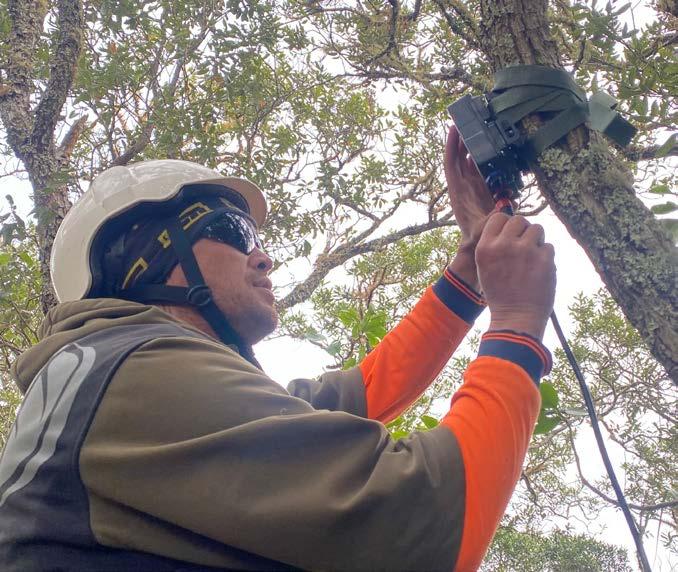
“The camera network helped us conclude that there was only one rat on island, and it was instrumental in determining where to lay toxic baits.”
“The AI cameras sent us alerts when the rat was seen on camera. This gave us realtime information about the rat’s location and direction of travel which really helped us target it,” explains Claire.
The rat was filmed stocking up on toxic bait over four days in August, and since 8 August there have been no further sightings on the network of cameras. Last week a DOC rodent detection dog and handler, undertook a sweep of the island with no detections – giving DOC confidence to declare the rat dead.
The eradication is a big relief as the island is a key recovery site for one of New Zealand’s rarest birds, the tūturuatu/shore plover, with just 250 individuals remaining nationwide. A single rat could have devastated the small island population.
“Boat owners can help keep islands pest free by checking their vessel and gear for rats, mice, ants and skinks before departure. You can also set traps or bait stations on your vessel and in the area it is stored.”

87 Very favourable chance (6,11)
Tumbled over and over (6)
or u (5)
Donkey (3)
Mountains (4)
Sack (7)
Soak up (6) 8 Lass (4)
Exemption from punishment or loss (8)
Recluse (6)
Asymmetrical (10)
Female deer (4)
Retrieve from destruction (7)
Execution device (10)
Reign (4) 23 Cast metal bar (5) 24 Leading (8) 26 Joss stick (7)
Finishes (4)
Distinct lower part of wall (4)
Irritated, annoyed (5)
Summer flower (8) 47 Moral principles (6) 48 Making reference to (10)
49 Student’s table (4) 50 Traveller’s belongings (7)
Jetty (4)
(7)
Wealth (6)
(5)
(6)
(5)
Small dagger (8)


Zane Bryhn, Coastguard Hibiscus crew chief www.coastguardhibiscus.org.nz
It has been a mild winter, and we are now seeing some of those gorgeous days where the wind and sun plays ball, and the boaties are certainly making the most of it. We missed out on a significant portion of summer last year with Hibiscus Rescue One being out of service until April this year, so we were very reliant on bailment boats from Coastguard New Zealand. It’s not the same as having your own vessel so we are extremely happy to have her back for the summer period servicing the Hauraki Gulf and beyond. Our Coastguard Hibiscus crew has used the winter period getting refamiliarised with the vessel and preparing ourselves for the busy season. Significant hours are spent by our volunteers in making sure that they are up to the task no matter what the weather is as normally those jobs come in the weather that we would rather be tucked up at home. So if you see us out there in the heavy weather, we are ensuring that we are fit for purpose and can assist in any weather (well almost any weather). It always blows my mind how dedicated and loyal our volunteers are. When I was writing this, I thought to myself it would be interesting to add up the tenure of our whole current crew. We currently have 32 active crew from Deckhand through to Skipper and have a total of 250 years of service with Coastguard Hibiscus, which is amazing and shows the dedication and the passion to the cause. We do it because we love it.
It’s time to get ready for summer and a lot of boats have sat in driveways over the last nine months and it is imperative to make sure it is in ship shape. For petrol-powered craft, one of the things to consider if you are not using your boat for a while is the condition of the fuel. Petrol deteriorates quickly, becoming ‘stale’ after just a few weeks. Petrol is a complex mixture of different components, each with specific properties that contribute to its performance. These components evaporate at different rates, adversely affecting the way the fuel performs over time. Problems with stale fuel are especially common at the beginning of a new boating season, when the boat is used for the first time in months. If the fuel in the tank is old, you can expect trouble. In most cases, the effects are minor: the engine refuses to start or run properly and the voyage is aborted before any damage is done. Sometimes, though, degraded fuel can cause more serious problems requiring costly engine and fuel system repairs, or else result in breakdowns at sea.
Batteries also, if not maintained, can cause issues. Whilst a quick jumpstart can resolve the issue, it is extremely important to maintain your batteries over times of non use. There are some great products out there that maintain your batteries while not in use. This extends the lifecycle of a battery as well as keeping costly replacements to a minimum. Stay safe, ensure your boat is prepared and enjoy what I hope will be a very long summer.
Our volunteers
Coastguard Hibiscus has just celebrated four volunteers this year who have a total tenure of 55 years of service between them.




Reg Werner – 20 years service. He is the head of Maintenance team, one of our dedicated skippers and oversaw the rebuild and refit of our rescue vessel last year.
Ian Robertson – 15 years service. Ian is also a dedicated skipper who is hugely knowledgeable and passes this knowledge on to our crew, especially night time training using our systems and lights to navigate at night.
Dan McGowan – 10 years service. Another dedicated skipper, Dan was previously president of our unit so has added his skillset on and off the water.
Dave Tilley – 10 years service. The newest dedicated skipper in our unit. Dave was also previously the Crew Chief for our unit and currently holds the Safety Officer role so adds huge value on and off the water.

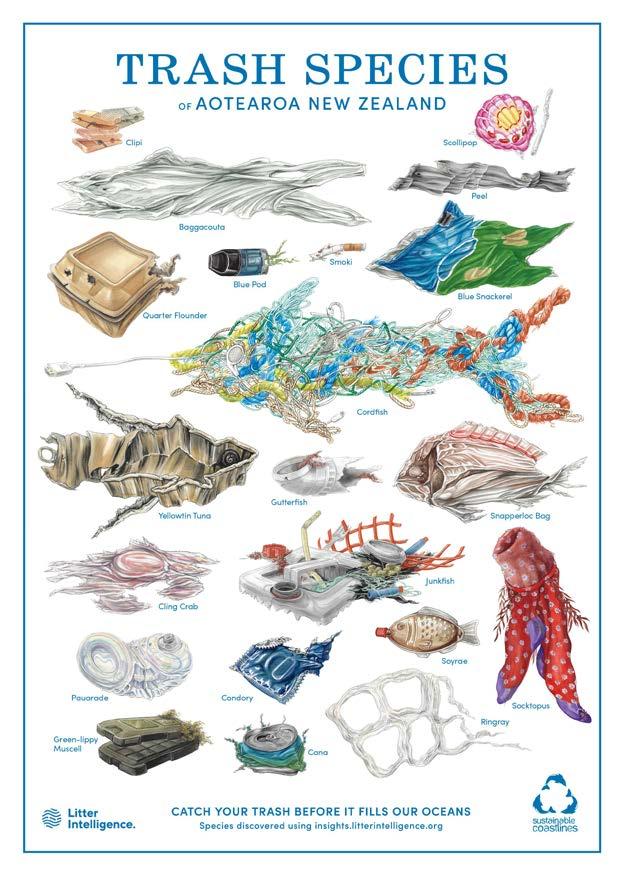
Renowned wildlife artist, Erin Forsyth, has used her creative licence to recreate the iconic Kiwi Fish Species Poster we see adorning the walls of takeaway shops around the motu – replacing our unique kaimoana with a new breed of trashy sealife – The Trash Species of Aotearoa New Zealand. The campaign brings to life the state of our oceans and encourages people to catch their litter to prevent these trash species from taking over. On average, 436 litter items per 1000m2 have been found in coastal survey sites in Auckland. 72% of the litter found is plastic (‘Plastic’ and ‘Foamed Plastic’ categories together) The top litter item is ‘Unidentifiable hard plastic fragments’. The second most common litter item is ‘Glass or ceramic fragments’.
Surf club cafe open Ōrewa Surf Life Saving Club cafe is now open for business Wednesday to Friday 10am-9pm and Saturday to Sunday 8am-9pm. Every dollar spent at our Ōrewa Surf Life Saving Club Cafe supports our essential Lifeguard Service. New members welcome!.
Want to know more about luxury resort-style retirement living at The Botanic Silverdale?
Join us for our Special Open Weekend
Two and three bedroom villas available
Our team will be available to answer your questions and show you around our beautifully landscaped village.
Saturday 12 and Sunday 13 October, 10–4pm at 17 Small Road, Silverdale

Love life on your terms.
At Summerset Milldale there are fewer chores and more choice. So if you’re done with gardening, you can hang up your gloves. But if you’re a big fan of getting amongst the flowerbeds, there’s a community of green-thumbs just waiting to meet you.
Summerset Milldale has three bedroom homes available now with flexible pricing from $1,093,000.* Then all you need to do is think about whether you’ll use your $20,000 cash back for that special holiday, a new car, or to cover two years of weekly fees.#
Love the life you choose.
Open Day
Sunday 13 October, 10am - 2pm
Summerset Milldale 50 Waiwai Drive, Milldale Sales suite entrance on Te Taruna Drive 09 304 1632 | milldale.sales@summerset.co.nz


David Cooper, physiotherapist david@kineticsrehab.co.nz
A certain level of fear affects us about the latter stages of aging, yet for most I suspect it is more to do with a loss of function than the loss of life. The prospect of death itself doesn’t trouble me per se, it is more the process of dying that would command my attention. I want to take a swing at this seemingly heavy topic with a different perspective. So often we talk about the years of life, instead of the life in those years. Though we may never know when our time comes, it’s safe to say we live in an aging population. As we age what sort of quality of life do we wish for ourselves, or those closest to us? Can we influence that quality of life in our younger years and, if so, how?
Recently the term “marginal decade” was coined in reference to the last decade, whenever it may be. The research around this is still developing but hypothetically, we can prepare today for the quality of life we maintain in the marginal decade. If you want to live independently you will have to be able to do the following:
1. Walk around the supermarket comfortably. 2. Carry 5-10kg groceries from supermarket to the car, then into the home. 3. Get up or down stairs with relative ease. 4. Shower, self-care and dress yourself independently. 5. Stay cognitively sharp So let’s back pedal and consider how we may need to address these aspects now.
Walking – In our 40s, we should tolerate a 5-8km aerobic walk. In our 60s-70s, it might go down to walking 2-5km at a
comfortable pace.
Lifting weight – I personally believe physical strength is the most important thing to maintain as we age. As a 30-40yr old we may be able to carry 25kg+. At 4050yrs it could be 20kg. In our 60s carting 15kg around should still be possible.
Navigating stairs – In our 30s this could be performing 20-30 squats or lunges in a row. As we age that might reduce to 10-15 reps.
Independent self-care – A key aspect of this is balance! How long can you stand on one foot? There is great research for agematched balance to test yourself against so check them out!
Mental Agility – Challenge yourself mentally! Learn something new, an instrument or language. Read books! Play sudoku. Perhaps most importantly, stay socially engaged as this is shown to be one of the best ways to avoid neurodegenerative conditions. Then there are healthy food choices, sleep more, stress less, read more etc. Of course the list of “how to live” is endless, but I’m convinced that anything is better than nothing, no matter how small.
Ultimately end of life will come to all of us. Though the exact circumstances are out of our control, much of what we may hope for can be influenced in our life choices now. As a husband, father, and advocate for all things healthy, I would encourage everyone to consider the small things that can be done now, that make a big difference in our marginal decade.
As a working parent, Suia Westbrook isn’t always able to take leave during the school holidays.
And when she is, like many local business owners, she’s on a budget when it comes to holiday activities. Dad Artje is also a local business owner. So when it comes to keeping their five-year-old entertained over the school holidays, they’re always on the lookout for new ideas.
School holidays on the Hibiscus Coast offer a perfect opportunity for families to explore the area’s natural beauty and engage in fun, free activities with the kids. We’re at the halfway point and if you’re running out of ways to keep the little ones entertained, check out this list of local favourites that Suia was willing to share. Best of all, they’re all free activities so you can make the most of the break without breaking the bank:
Beach Days: The Coast is known for its stunning beaches. Take the kids to Ōrewa Beach or Manly Beach for a day of swimming, sandcastle building, and exploring rock pools. Bring a picnic, some games, and enjoy the adventurous playgrounds
Coastal Walks and Bike Rides: Explore the local trails like the Te Ara Tahuna Estuary Cycleway and Walkway. Perfect for walking, biking, and scootering with the kids. There are playgrounds along the way where they can take a break and have a play. And you also pass Millie’s cafe, so the parents can stay caffeinated.
Explore Local Parks: There are plenty of parks in the area, such as Western Reserve and Stanmore Bay Park, which offer wide open spaces for a game of frisbee, soccer, or just running around and burning all that energy!
Visit the Estuary Arts Centre: The Estuary Arts Centre Ōrewa hosts free exhibitions that are family-friendly. There
are also a great bunch of affordable art classes they offer for kids from 5 to 11 years. A great chance for the kids to see local art and get inspired to create their own masterpieces.
Go on a Nature Scavenger Hunt: Organise a nature scavenger hunt at Shakespear Regional Park or Alice Eaves Scenic Reserve. Create a list of items for the kids to find they need to tick off: like seashells, specific plants, or animal tracks, making the adventure educational and exciting. Library Time: The Ōrewa Library and Whangaparāoa Library often have free school holiday events like storytelling sessions, arts and crafts, and reading challenges. Even if there’s no event, it’s a cosy spot to read together or borrow books and even games for home.
Skate Park: If your kids enjoy skating or scootering, head to one of the local skate parks like the one at Stanmore Bay Leisure Centre or in Ōrewa. It’s a great way for them to practice their skills and again, burn that energy.
Join an eco working bee: To end the holidays, join the community weeding session to protect native plants at Ōtanerua Reserve (classified as a Significant Ecological Area) in Hatfields Beach. A great way to show kids the importance of caring for our environment.
Hunt out some history: Learn more about our community heritage by exploring the Pioneer Village this weekend. They have a kids worksheets to engage the little ones as you wander around the village.
Indoor Play: With unpredictable spring weather, make the most of a rainy day by challenging the kids to be creative. Build a pillow fort in the lounge or try indoor camping and make smores in the oven.
Suia Westbrook, CoastLab owner

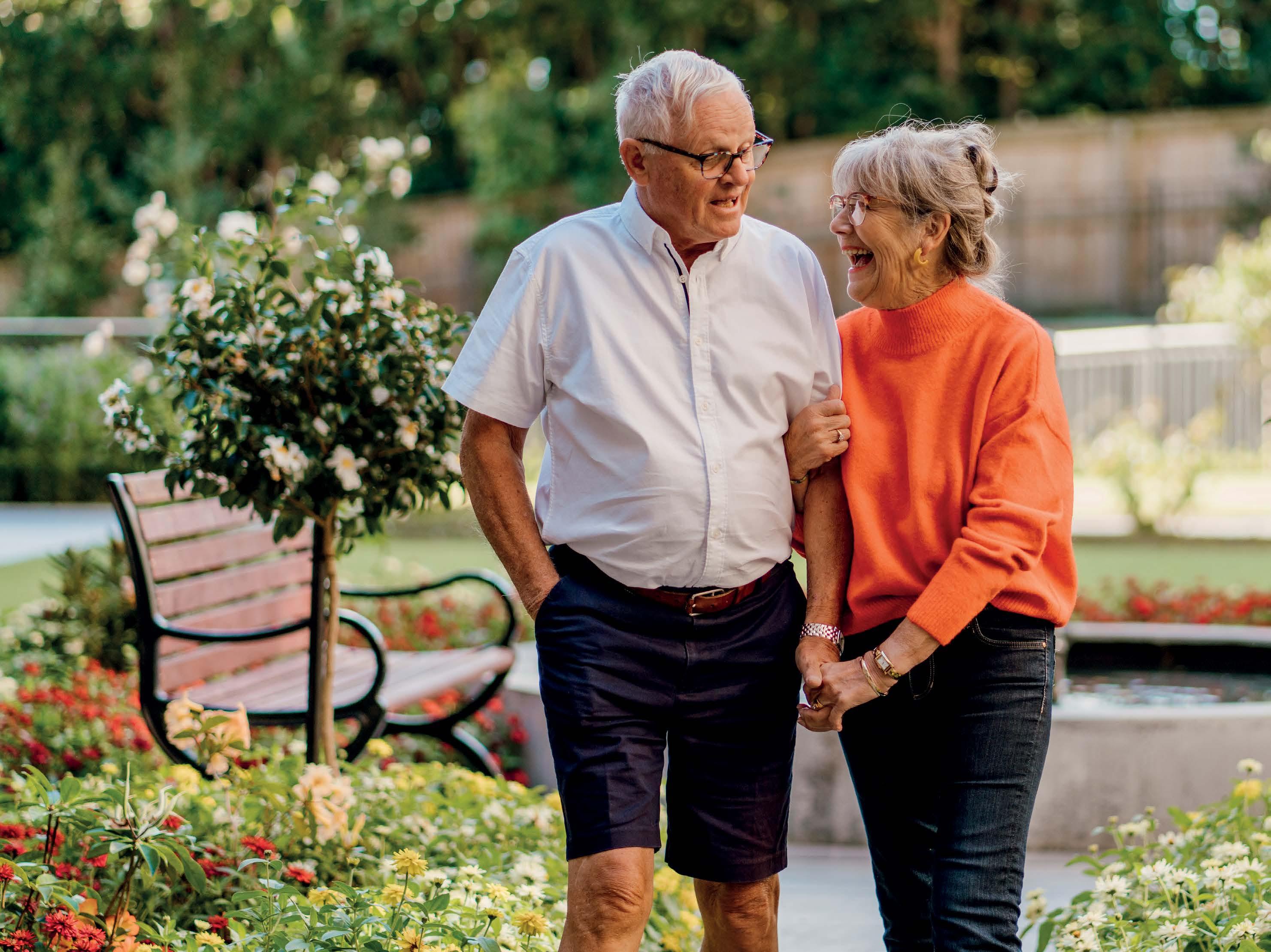

Many assume that hospice is only for people at the very end of their life.
But Harbour Hospice care is available to anyone who needs specialist support at any stage of a life-limiting illness – and the earlier in a patient’s journey hospice can support them, the more it can do to help them live well in the place they call home with the people they love.
Jan Nichols, Harbour Hospice chief executive shares, “We help prepare patients for death in many ways including through social work support, counselling, spiritual
care and cultural support, complementary therapy, social connection through support groups, and of course specialist expert nursing and medical care.
“But all of these services actually support people to live well and die well. Most of our care is provided in people’s homes, where they feel most comfortable, through our community teams. And 74 percent of the people who come into our Inpatient Unit do so for respite care or symptom management – so they leave feeling better than when they came in.”
and Julie
and

Ex-Marine Scott Beson has type 1 diabetes and Chronic Obstructive Pulmonary Disease (COPD) - a progressive illness that affects the respiratory system. His wife Julie is his primary carer. Before they joined the Harbour Hospice whānau their lives had been in constant upheaval. “In the 24 months before Scott went into Hospice care he was in and out of hospital 23 times,” Julie says. “Now the hospital visits are far, far fewer and our lives are more settled.” Scott is cared for at home by Julie with Harbour Hospice support, and both say they don’t know what they’d do if hospice respite care wasn’t available to them. Importantly, the carer also gets a much-needed break to rest and recharge their batteries. “So often the caregiver is put on the backburner yet your whole world is dominated by caring for your loved one and you need support too,” Julie says. Julie has regular counselling sessions with a hospice counsellor, saying, “It gives me a place to vent and explain my feelings. I go from being very sad to very upset and angry to ‘why has this happened?’ and the counsellor has helped me to understand that all of this is okay.” Scott has been with Harbour Hospice almost two years. “This full and frank approach has helped us prepare for Scott’s passing. And I think that’s important, to be as prepared as you can be,” Julie says.


Elizabeth Apiata was a regular at Harbour Hospice’s Inpatient Unit. She stayed every three months, for one week, for respite care and symptom management.

One day it was the big, bright sunflowers that drew Elizabeth Apiata out of her Inpatient room and into the Harbour Hospice gardens. The nurses couldn’t find her and searched up and down the hallways in mild panic. When Elizabeth wandered back in they made a sign for her to leave on her bed. ‘Gone for a walk in the garden’, it said. And she started using it every day. When Elizabeth died a few months ago, she had been a patient with Harbour Hospice for well over a year. She said the support enabled her to focus on the things that gave her joy – like flowers and her family. The whānau was introduced to hospice two years after Elizabeth’s diagnosis, when it was suggested to Elizabeth by her GP. But to begin, the family questioned why a service like hospice was necessary so early on in Elizabeth’s journey. Elizabeth had cancer and lived with her daughter Moana and son-in-law, Lamoni. Moana took turns with her sister, Danielle, and Nana, Ngaro, to care for Elizabeth one week at a time each. It was Hospice that brought the family together to make a plan for Elizabeth’s care, because Moana had felt she needed more support from the family. She had been trying to juggle her mum’s care with her work and it had started to become too much. Elizabeth loved the multidisciplinary approach to her care. “The Māori way is to have lots of people [from your whānau] caring for you, and I look at hospice and see that the hospice way is the Māori way,” Moana adds, “The values of hospice are aligned with the values of Māori. It’s family-orientated, it’s open and it’s ‘lots of people’.”
Amanda Fowler has been announced as the new chief executive for Harbour Hospice, taking over the reins from Jan Nichols who is retiring in late November after 13 years at the helm. Amanda has a long history with hospice, holding numerous roles first at Mercy Hospice, before becoming HR Manager at Hibiscus Hospice and later People & Culture Manager at Harbour Hospice. Amanda, who will officially join the team in mid-November, says she is “honoured” to lead an organisation that is at the heart of the community. “My focus will be on continuing to uphold the excellence in care that Harbour Hospice is known for, while ensuring that we meet the challenges of an evolving sector together. I look forward to collaborating with the incredible team, volunteers and the wider community to advance our mission of providing the highest quality palliative care to those who need us most,” she said.



Whangaparāoa Methodist Parish

Donations
Mon-Fri: 10am-4pm | Saturday: 10am-2pm
76 Red Beach Rd, Red Beach | phone 426 5615

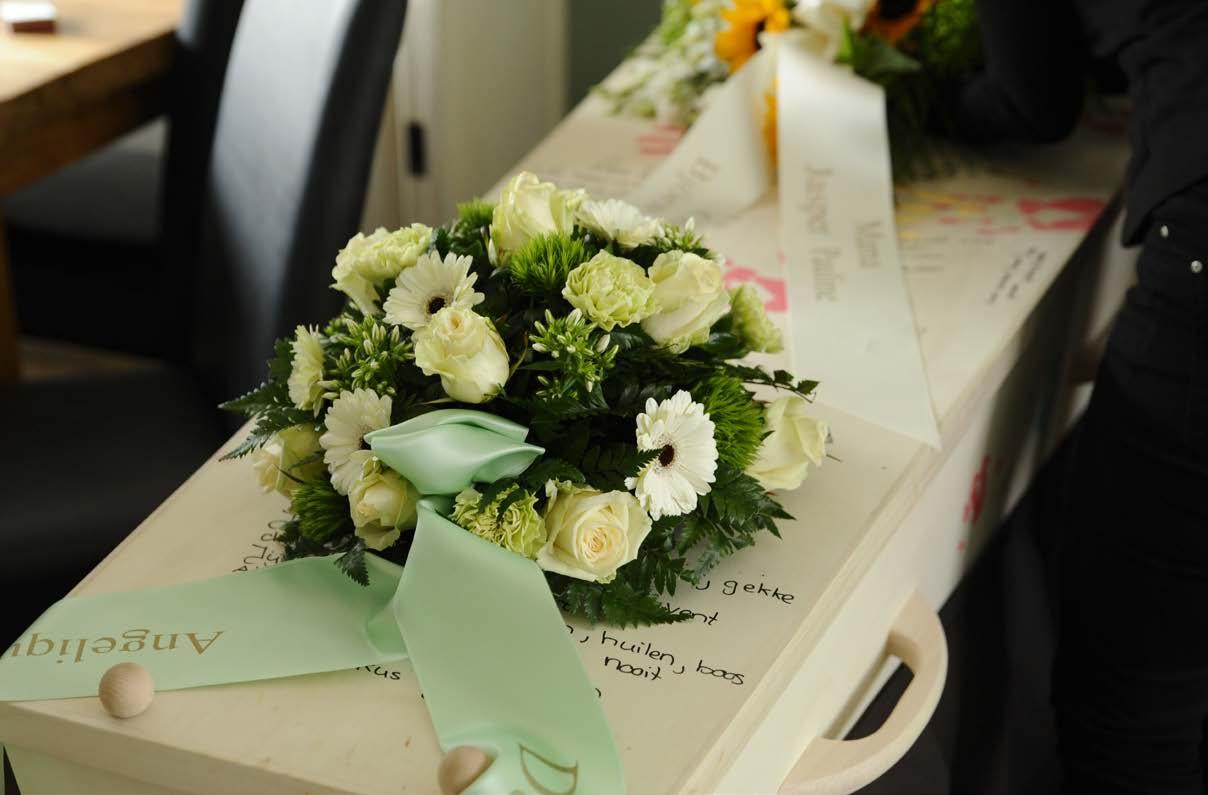
When people leave your funeral wouldn’t you like them not only to know more about your life, but also what contributed to making you the person they knew?
Jane Bissell’s recent workshop at the Whangaparāoa Library, “What’s Your Story: Getting Started With Life Writing”, was extremely popular. The room was packed with aspiring writers. When she raised the idea of writing your own eulogy however, there was a collective gasp in the room. Clearly a memoir was more what the participants had in mind! Times have changed and the idea of a eulogy being “a speech that highly praises someone, especially someone who has just died” is a thing of the past. Similarly, a dry account of life milestones is not what people really want to hear at a funeral. Nor a series of “funny anecdotes” that may or may not reflect a person’s life. Of course they have a place, but interesting and honest accounts of the person’s life and personality make for a much more engaging farewell. So why

not prepare your own farewell?
Writing your own story is a wonderful opportunity to share personal memories of important events and people, along with defining moments in your life – and all from your own perspective. But where do you even start? Here’s a few questions to consider.
What are your most precious memories?
What and/or who has contributed to shaping you and your perspective on life?
What and/or who are you most grateful for?
What are you most proud of? Any regrets? What challenges, losses or sadness in your life would you like to share?
Do you have any insights from your life journey that you’d like shared with friends or family – and maybe future generations?
The list of thoughtful questions goes on and there is no time like the present to make a start on addressing them!
Helen Rutledge is a Celebrant on the Hibiscus Coast.
Planning our own funerals can be surprisingly satisfying. At Dil’s, we believe that creating a beautiful funeral starts with a good conversation. So why not drop in for coffee and a chat? It’s your daylet’s make it perfect.


In Western society we have lost our connection with death – and there is a lot of fear and anxiety around that. We shy away from reflecting on our mortality or planning for our death. While it’s important to embrace conversations about death and dying, you don’t have to do it alone.
An End of Life Doula can help educate on what a person’s choices are, empower them to make informed decisions, and advocate for them when they can no longer communicate. Just by holding space for deep and sacred conversations, helps to ease a person’s fear and allow a better, more healthy journey as they approach death.
The doula accompanies a person, and those caring for them, in a non-judgemental, non-medical way, providing holistic care which includes practical, cultural, spiritual, emotional and social support. Put simply, the doula meets the person (or their carers) wherever they are at in their journey, and works out how best to support them to live their best life right up to the end, and to plan for their death and beyond. We fill the gaps that our health providers can’t address. So when would you use an End of Life doula?
Hard conversations: A dying person may not want to have important conversations
with their loved ones, especially if their loved ones are not accepting that death is inevitable. A person wanting to die at home may need help talking to family who aren’t confident about it.
Dying alone: An elderly person, or someone living with life-limiting illness who doesn’t have any support, or an elderly couple looking after each other. Or their children are overseas or not able to be there.
Terminal diagnosis: Hospital discharges / post-diagnosis can be overwhelming. A doula can help a person come to terms with, and navigate their treatment and plans.
Advance planning: Everyone over 40 years of age should make plans for an unexpected serious health issue where they can’t communicate. Or for how they want to die and what they want to happen afterwards. Advanced planning avoids family having to make serious decisions while they are deep in grief. It also avoids family guessing and arguing about ‘what mum would have wanted’ for example.
Guiding family: Families and friends navigating a person’s serious illness can also need support. Sometimes we work with the support team rather than the person who’s dying.
Treza Gallogly is Chair of the End of Life Doula Alliance Aotearoa, www.eldaa.org.nz
Every day, you make decisions about what you eat, drink, wear, and do. Most of these decisions don’t warrant much thought. But what happens if you are no longer competent to make decisions for yourself? While you are mentally capable, you can appoint a person (known as the attorney) under an Enduring Power of Attorney in relation to your personal care and welfare. This person can then make decisions about the medical treatment that you may need if you are no longer able to make decisions for yourself.
An Advance Directive (also known as a “Living Will”) is another important document to consider. It can assist by recording, in more detail, the kinds of treatments, drugs or other medical procedures you would or wouldn’t want to be given. It can also go further on matters of end of life care that are important to you, helping to ensure your wishes are adhered to. It cannot however be used to facilitate assisted dying.
Although it is not essential to use a lawyer to make an Advance Directive, it may help ensure that your Advance Directive is respected. To make an Advance Directive, a person must be mentally competent, free from undue influence, sufficiently informed, and they must have intended for the directive to apply to the circumstances at the time of the relevant event or episode. It’s a good idea to start thinking about this early. Discuss your wishes and intentions with your clinicians and trusted family or support persons now. Seek advice from your lawyer to ensure you have your important legal documents in place. This can help ensure that your wishes are respected should you become unable to make decisions for yourself in the future.
Rika Louw, Solicitor at North Harbour Law
The Code of Health and Disability Services Consumers’ Rights (the Code) states that every consumer has the right to refuse services and to withdraw consent to services.
Most people don’t want to talk about death. However, at one time, death was a normal part of our lives. People were cared for and died at home, and the community grieved, celebrated and prepared for the burial together. Many cultures, Māori and Irish included, were similar in that regard. This reticence to talk about death and dying was why we started the local death café – to create a space where it’s OK.
One of the over-arching themes from our recent Dying Matters Week panels at the library (we had representatives from legal, hospice, local cemetery, an end-of-life doula, funeral director and celebrant) were the issues that arise when we don’t plan ahead.
Approximately 80 per cent of us will have advanced warning that our end of life is in view. At that point, only 50 per cent of us will
have the capacity to make all the decisions required to put our affairs in order. When we start planning while we are healthy:
• We make better decisions
• We can discuss our wishes with loved ones
• It saves money
• It gives us peace of mind
Death is part of the cycle of life, so there’s no reason to wait until it’s approaching before we plan for it. And 20 per cent of us will have no warning. Start early, so when the time comes, your whanau can focus on what is really important – spending time with those you love and honouring their wishes when they are gone. In the meantime, you can get on with living! Kelly Townsend is a funeral celebrant, Death Café host and is passionate about living and dying consciously.




EACH number in our CodeCracker grid represents a different letter of the alphabet. For example, today 24 represents G so fill in G every time the figure 24 appears. You have one letter in the control grid to start you off. Enter it in the appropriate
We’re bringing a smarter approach to 70+ retirement living.
Our unique operating model is designed to protect the nest egg you’ve worked hard for. A lower deferred management fee, share of capital gains and guaranteed buy back are just some of the features packed into our offer.
We think we have something special here at Vivid Living, so come along and see for yourself.




From old curtains to losing lotto tickets, and even the sail from an actual Peter Blake yacht – the annual Ōrewa College Wearable Art House competition didn’t fail to impress.
“It’s amazing what you can create when you rethink what’s considered rubbish,” said Joel Dickinson House Director at Ōrewa College. Founded more than ten years ago, the competition is close to many a teacher’s heart. Even retired textile teacher Di Sinclair was spotted in the audience. Clearly her passion has been passed down because this year, Di’s granddaughter Zoe has entered for the first time. “She roped us all in to help folding newspapers,” With the ring of the bell, and a crescendo of pop music, the theatre is flooded by students eager to secure a prime spot to cheer on their friends. Sandwiched in between intermediate students hurriedly scoffing lunch, we received insider tips on what to watch out for.
It’s amazing what you can create when you rethink what’s considered rubbish
The heads up about “Broken Dreams,” was sound – the year 7/8 designers shared a sentiment that hits home for many a local hopeful, “When a person buys a lotto ticket or a travel brochure, they center their hopes and dreams around it. The lotto ticket loses and the travel brochure costs too much, breaking their dreams. This garment takes these broken dreams and remakes them into something brilliant, bringing back the peoples hopes.” Thor may have lost his belly on the runway, and Riley’s wings may have warped, but it was clear that Ōrewa College’s winning designs could easily share the stage with the Wellington World of Wearable Arts’ international creations.


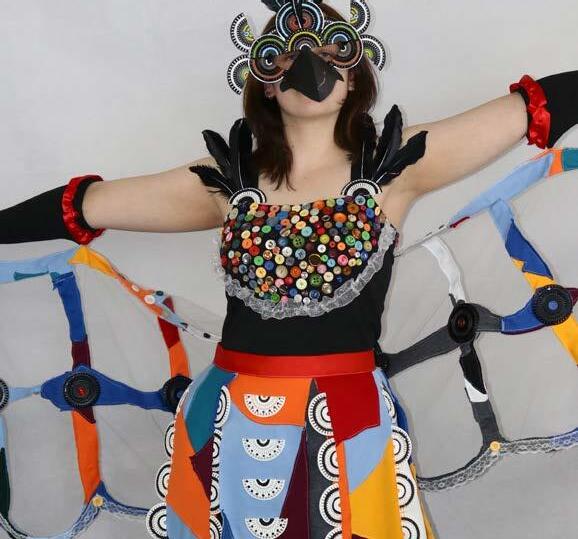

My first encounter with WOW was in 2023. Uncertain of what to expect beyond a fashion show of models stalking down a runway wearing ‘homemade’ outfits, I could not have been more wrong. WOW is nothing shy of a spectacular show – a delectable mix of theatre, art, fashion, music and dance, ‘wow’ sums it up perfectly. The pieces themselves have seemingly stepped of the gallery wall and onto the runway.
Inspired by the creative, boundary-testing atmosphere, I bought myself a sketchbook the very next day and spent the next few months crafting my own wearable art dress. Clearly my dress did not make the cut, or I would have opened with that news. What I did come away with though was an appreciation of just how much work and heart goes into each piece.
Undeterred, I returned to Wellington this year to see what I missed out on. Once again, WOW did not disappoint. This years’ winning piece setting the bar even higher.
Seven years in the making, American, Grace Duval’s entry, ‘Curves ahead’, was a show stopping blend of road cones, safety netting and vinyl signs inspired by the rebuilding as a nation after witnessing the Kaikoura earthquake in 2017.
I returned home with renewed vigour and inspiration for my next entry.
Given it was my third visit to Wellington, I had seen the must-sees – Wētā workshop, Te Papa, Parliament building and the Cable car – so I dug a little deeper to unearth some hidden treasures and explore beyond the TSB Arena.
Ziggurat: Further down Cuba Street, past all the brand stores, I stumbled into op shop heaven. Two stores in one, Ziggurat houses an incredible collection of vintage clothing, hats, jewellery and shoes that made me think I’d walked into a dress-up
box and absolutely had to partake. QT Hotel: Formerly The Art Hotel, it showcases an extraordinary collection. Walking into the foyer is like visiting a gallery – walk past the life-sized bull made from corned beef tins, past the half-stuffed half-metal sculpture rabbits, past the signature Rita Angus, and make your way to the bar where Dick Frizzell studies you intently as you sip your wine.

The Library: Heading back to our rather tame (in comparison) hotel, a small sign caught our eye, promising great cocktails, live music and ambience. I doubted this promise as we made our way up the three floors of fire exit stairs to a fire exit door. If not for a group exiting at that moment, we may well have missed the entrance. The hike was however, well worth it. It felt as if we’d walked into an old-world bookstore, plush velvet seating, antique pictures and a rainbow plethora of books lining the walls. The library, in theme with WOW had a “World of Drinkable Arts” menu for the occasion, with what was described as 'instagram-able’ cocktails to match each section of the show.
Like most discoveries this trip, off-thebeaten track, and hidden from those not “in the know”, I barely scratched the surface. I am certain my next trip will reveal more gems.
Lorry McCarthy, Graphic Designer and budding WOW entrant.




8
By Caitlin Johnston
Mahurangi resident Andrew Finlay recently returned from a field trip in Vanuatu where he worked alongside an organisation to protect and restore forests from the impacts of climate change and disasters.
Finlay is Tearfund New Zealand’s grant manager and he spent two weeks in the South Pacific island nation with Tearfund’s farming and enterprise partner Nasituan to assist with a new programme focused on protecting the landscape.
• Monthly and end of year accounts and tax returns.
• Business planning and advice
• Personal Tax Returns
• ACC Coverplus Xtra
• Cashbooks, Xero & MYOB
• GST, PAYE, FBT
• Agent with IRD
Fax: 09 424 4688 greg@douglasconsulting.co.nz www.douglasconsulting.co.nz
There are two big problems facing rural communities in Vanuatu – it is the most disaster-exposed country in the world and, along with high levels of unemployment, this pushes families below the poverty line.
Nasituan was established in 2011 to train and mentor farmers in rural communities on how to be resilient in the face of disasters, teaching sustainable farming techniques, and the viability of diversifying crops such as growing coffee beans.
Finlay helped to set up Nasituan and has seen it grow from a small communityled organisation focused on agriculture development to a social enterprise. It has given thousands of farmers the opportunity to be able to afford the basics for their families such as schooling, food, medical care and housing.
“Nasituan builds on their existing agricultural knowledge and equips growers with additional skills and resources to succeed,” Finlay says.
The organisation has trained more than 2000 farmers in coffee growing, and other agricultural techniques.
“Vanuatu’s tropical climate and rich volcanic soil make it the perfect environment for farming quality coffee. Nasituan is also developing better ways of growing coffee to ensure it is climate resilient.






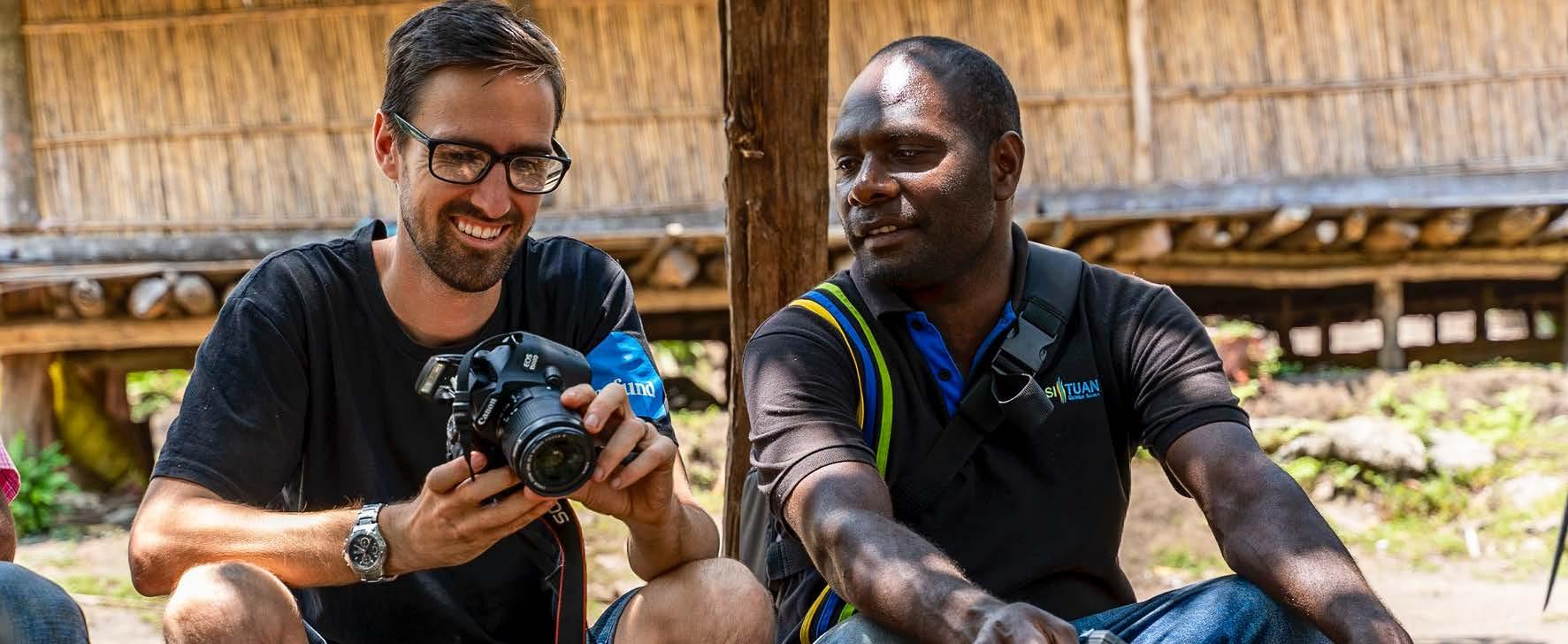
“Secondly, coffee has great market potential. Nasituan trains local growers on how to get the best out of their crops to sell to market, so they can generate extra income for necessities.”
A success story which left a lasting impression on Finlay was of a farmer who, after training with Nasituan, went on to become one of the largest producers of coffee in the local area. This led to him starting a second business in food transportation after his coffee earnings enabled him to buy a four-wheel drive.
“It was through coffee farming that he was able to improve his livelihood, income and standard of living, and this has benefited his family. These sort of success stories are always encouraging.”
With its training and mentoring facilities firmly rooted, the organisation has turned its focus to protecting and restoring the landscape that local farmers in order to continue protecting and improving their livelihoods.
“If you want to have good crops and good livelihoods, you’ve also got to look after your environment and look after your ecosystems.”
To achieve this, Nasituan, with support from Tearfund, has started the Life and Land Programme.
Finlay says he is excited about the programme getting underway and seeing
the organisation progress even more. The programme’s purpose is to develop and implement strategies that restore the environment and protect crops from natural disasters.
“If you’ve got trees around your coffee plots then they are less prone to wind damage or flooding. This kind of forest enhancement will improve local ecosystems, protect food security and livelihoods.”
Finlay’s time in Vanuatu working included evaluating existing work, strategy planning and consulting with the community to understand the work that was required. Over the next few years, in partnership with Tearfund, Nasituan hopes to continue to enhance the sustainability of farming in the area, generate more income for local farmers through carbon credits and improve the livelihoods of a further 600 farmers.
This project in Vanuatu is part of a bigger programme called SAFE (Safe, Aware, Free, Empowered) funded by the Ministry of Foreign Affairs and Kiwi donations. The SAFE programme operates in five countries – Solomons, Fiji, Vanuatu, Sri Lanka and Myanmar. This multimillion dollar programme aims to prevent vulnerable communities from being trafficked and improve rural livelihoods in Southeast Asia and the Pacific.








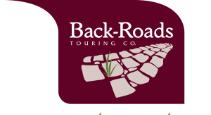




Ed Amon edamonnz@gmail.com
Summer is creeping into our lives. We are on that seasonal cusp when we sometimes wear shorts during the day and turn the heat pump on during the night. Many of us are planning our summer holidays. I have noticed that all of my friends’ holiday plans are based in the southern hemisphere. Well, e hoa mā, today I am going to make the case for having the summer holiday in the cold northern hemisphere. Specifically, Italy. In 2018, my wife and I emptied out our savings and visited Italy for two weeks. Italy’s charm in the winter is unmatched. The cool, crisp atmosphere, festive ambiance, and fewer tourists make it an ideal time for exploration. Each city has its own personality with its own unique blend of culture and history. We landed in Milan on Christmas eve. The city, known for its fashion, was transformed into a stunning winter wonderland. A Christmas morning visit to the Piazza del Duomo, with its grand gothic cathedral, was the best start to a Christmas day. Most of our time spent in Milan was just walking the streets and using public transport to visit random locations. Even now whenever I think of Milan, I can smell the scent of mulled wine in the air. Short stint in Milan and then off to Venice. Personally, the canals got boring real quick. My highlight was the visit to Ghetto di Venezia. This is where you find the muti-faceted history of Venice grounded in love, prejudice, perseverance, and community. This is where you find the true people’s history of Venice. Next stop Florence. Famous for its Renaissance art and architecture, the city was abuzz with energy ahead of New Year’s celebrations. Everybody can google “things to do in Florence”. Ours was a unique
experience. We found a tour guide named Nicola Bernini on Airbnb, who showed us Florence through the eyes of Michelangelo. We walked the streets of Florence just as Michelangelo would have. It gives you a unique perspective of the city culminating in the visit to Galleria dell’Accademia di Firenze and the viewing of Michelangelo’s David. I highly recommend this city.
After Florence, we headed south to Naples, which was all about food. The cramped winding streets with Vespas buzzing around use reminded me of the bustling city of Karachi, Pakistan, where I grew up. Our Airbnb spot was right in Naples’ historic centre opposite the legendary Pizzeria Sorbillo where you line up to get a table and it is worth it. Remember that it is the one with the blue and white logo. Classic family rivalry has led to a couple of other Sorbillos on the same street. A stint in Naples cannot be complete without a day trip to Pompei. I recommend renting the audio guide which supercharges your experience. Finally, Rome. Winter in the Eternal City is magical – fewer crowds at the Colosseum and Vatican meant I could fully immerse myself in the city’s grandeur. Tip: Start your visit to St Peter’s Basilica with a guided tour of the underground Vatican Necropolis and St Peter’s tomb rather than entering though the main entrance. Just beautiful and historical. Italy in winter should now be on your bucket list. Some final tips. Follow the recommendations of your Airbnb host for restaurants – they never failed us; never eat at restaurants with pictures of the food outside or in the menu; and try to speak Italian for ordering food or asking directions, you will be loved for it.



passion for creating special travel for you is stronger than ever. We’ve learned a few things, we know the best way to do this well is to get close-up and personal about what you want most out of your journey.
Make an appointment now and we’ll match you up with the agent best suited to your destination. If you call in we’ll talk through a few ideas, then make an appointment, because our team are currently working with people who want the best out of their travel experiences, too.









An extensive traveller, you’d be hardpressed to name a popular destination that Whangaparāoa local, and Auto Super Shoppe owner, Mark Manihera hasn’t been to.
It helps that wife Katherine works in the travel industry and often has the inside word on the next big experience. But when she came home with an idea for a cruise through Vietnam and Cambodia, it took a bit of convincing for Mark to get on board.
All hesitation was washed away as soon as Mark set foot on the Mekong Princess, discovering a smaller, intimate experience than he had envisioned for a cruise.
The brainchild of a Vietnamese boatbuilding family, The Mekong Princess is a luxury river vessel small enough to visit hidden destinations inaccessible to the bigger cruise ships. And this was by intention – the family has built many a large river cruiser for larger companies.
As the boat navigated the scenic waters from Vietnam to Cambodia, it made scheduled stops along the way to immerse the travellers in the local culture:
Unlike most trips, he could sit back and leave all the coordination to someone else!
With the staff taking care of all their travel needs, Mark had the space to spend quality time with his travel companion.
call
Ph: 09 428 4490 / 021 035 0431 hibiscus@drivingmissdaisy.co.nz .drivingmissdaisy.co.nz otal Mobility Scheme cards acted supplie (Vendor Number: VBD580)
Driving Miss Daisy Hibiscus Coast


Vietnamese village: a day trip included visiting a small village unaccustomed to large-scale tourism which meant it was the ideal opportunity for the village to showcase it’s industry for coconut based products and provided Mark and his fellow traveller with an authentic insight into local life.
The Killing Fields: Stopping in Phnom Penh, Mark recommends the day trip to the “Killing Fields”. He says, “It’s an incredible experience – the sombre environment evokes an emotional response.” He learned a lot from the educational info on site

Join us to uncover a unique slice of Southeast Asia. Vietnam & Cambodia 15-day tour 12-27 October, 2025. Fully escorted with local English-speaking guides, and a YOU Travel Orewa host. Visit – the War Remnants Museum, Cu Chi Tunnels, Gieng Island, Cruise Mekong Delta, Zihuang Pagoda, Phnom Penh, Angkor Ban, Angkor Thom, Angkor Wat, Bayon Temple, Ta Prohm Temple. Highlight – 7 night cruise onboard the award-winning luxurious Mekong Princess from Ho Chi Minh to Siem Reap – 3 nights Ho Chi Minh + 3 nights Siem Reap. 4 Cabins remaining • Home pick-up.


acknowledging that the Khmer Rouge is a section of history he hadn’t been exposed to. Even more valuable was the opportunity to meet survivors of the holding prison and hearing their stories first-hand.
Blessing at Angkor Ban: Embarking on this cruise, the last thing Mark expected was a spiritual experience. But being blessed by local monks makes his highlight list, “I felt connected spiritually,” he says. It was a life-changing experience.
Back to school: The opportunity to join local children in their classroom was eyeopening for Mark and his companions. Some of these children rise at 4am to being the long walk to school.
Angkor architecture: Having spent time in a number of European cities, Mark is familiar with the reflection of history in architecture. Exploring Angor Wat, he describes what he saw as “just next level”. Touted as a journey about sensory awareness and personal enlightenment, the Mekong Princes definitely delivered for Mark. He shares, “It was a real privilege. I have returned feeling quite moved by this experience.”
Mark’s rave review inspired YOU Travel’s Kiri Martin. Connecting with the Vietnamese owners of the ship, Martin decided to charter a an exclusive tour – In 2025, 28 locals will experience a fully escorted experience aboard the Mekong Princess.





While waiting in Queenstown for the transit van that would take us to Te Anau, one of our guides remarked that, “the risk of visiting Fiordland is that you will never want to leave.” It sounded like a travel brochure cliché, but Local Matters journalist Jannette Thompson soon learned it was far from an exaggeration as she spent seven days as a guest of Heritage Expeditions on its Southern Fiords Discovery tour earlier this year …
“Kiwis aren’t supposed to fly” I told myself as the small pod we were strapped into lifted off the helipad and headed out across Lake Te Anau. I wondered if anyone would notice if I kept my eyes closed for the entire 45-minute flight to Te Awaroa/Long Sound, one of the remotest places in New Zealand. As well as the pilot, aptly named Snow, there were four other passengers, but it seemed I was the only one who was aware that there was just a thin wall of plexiglass between us and certain death.
But when the helicopter swept out over the lake, turned towards the south and started to climb above the snow-dusted Southern Alps, apprehension suddenly gave way to excitement. Finally, I was visiting Fiordland. Here, I hoped, I might experience a small slice of pre-human New Zealand, perhaps as it was when moa still roamed free and Haast eagles soared in the sky.
As the helicopter maintained its steady course south we flew over the Manapouri hydro dam, and the glimpses of waterfalls, mountain lakes or tarns, and orb rainbows took my breath away. The only sign of life was the occasional red deer track snaking across brown, barren hill sides. Our bird’s eye view of the alps gave us a sense of both their size and grandeur.
As we neared our destination, the helicopter descended into a thick bank of cloud flanked on either side by forested mountainsides. We emerged from the mist into the tranquil scene of Long Sound, bathed in sunlight with Heritage Explorer, our home for the next seven days, lying quietly at anchor.
The other guests had already landed and together, we made a party of 14 – a mixed bag of academics, a boat builder, marine
engineer, nurse, teacher, retirees from Australia and other professionals – plus six crew. Luggage and passengers were efficiently loaded onto the waiting zodiacs and ferried across to the Explorer. The journey had begun.
After welcomes, introductions and safety briefings, we were free to acquaint ourselves with our cabins and the vessel.
The 30-metre, four-deck wooden yacht was built in Picton 20 years ago and was powered by dual Scania 653 horsepower engines, with a cruising speed of 10 knots.
Fitted out with its wood interior and royal blue décor, there was certainly a feeling that this “expedition” was going to be done in style. The dining room provided 180-degree panoramas and the covered decks were the perfect viewing platforms for what lay ahead. A 24-hour coffee machine, plus snacks and fruit, a wellstocked library, open bar and French chef were a much-appreciated bonus.
As the Explorer made her way down the fiord to Rakituma/Preservation Inlet where we would spend our first night, we were captivated by the steep sided fiords carpeted in an ever-changing palette of green, changing in shadow and sunlight, with the occasional glimpse of white mountain tops. It was mesmerising. It was a landscape that formed over two millions years, and we learned that what we call sounds are actually fiords – troughs dug by glacial ice, which later filled with water. The exposed sides were eventually colonised by beech, rimu, miro, kahikatea, supplejack and rata, and of course, later still came an array of iconic New Zealand birdlife including kiwi, kakapo, tui, bellbirds and kereru.
As the bow waves rippled across the mirror-
like surface, it felt like we had entered a different time zone where days were measured not by digital devices, but by sunrises and sunsets, with everything governed by the weather. Fiordland has around 200 rain days a year with an average annual rainfall of seven metres. No wonder we’d been told to pack a good raincoat! On the following morning we rose to find the boat buffeted by a cold and wet south-westerly. Early risers were treated to the site of blue penguins bobbing around in the water like free range corks. But the patchwork of green on the hillsides that had been so evident in yesterday’s sunshine had disappeared into a uniform cloak of ominous green, worn with a ponderous blanket of grey above us. The day demanded thermals and wet weather gear. Thermallyinsulated Muck Boots, supplied by the Explorer, were donned and it was down to the zodiacs for a less than graceful boarding procedure. The solid easterly created a rhythmical rolling swell as we landed on the beach where the Puysegur lighthouse oil store was located, opposite Coal Island/ Te Puka-Hereka (The Tied Anchor). The landing proved tricky and, after mis-timing a wave, a few of us found ourselves squelching up the beach with boots full of seawater.
A tiny cemetery located beside the building was a stark reminder that the landing we had just accomplished had, in earlier times, claimed the lives of at least six people.
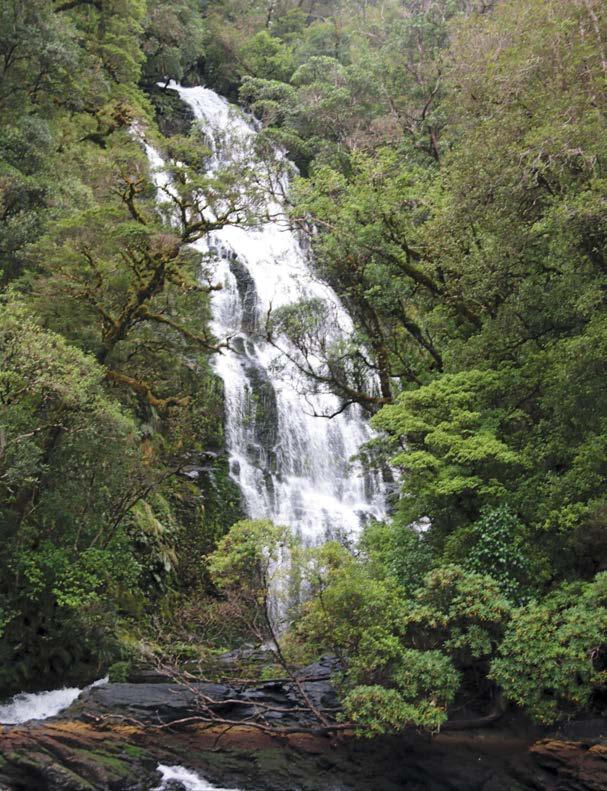


The tramp to the lighthouse provided us with our first

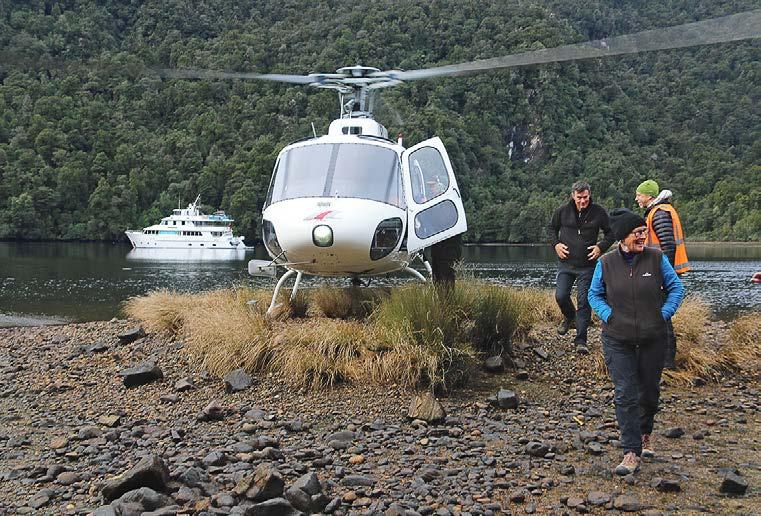


opportunity to experience Fiordland on the ground and we were accompanied by bellbirds and tui, and some very rowdy seabirds. Under a canopy of beech, we found pathways of moss, bracken trampled by deer, tree trunks dressed in lacey ferns and sandstone sculptured by fierce Tasman winds, sea spray and rain. Puysegur lighthouse was first illuminated in 1879 in one of the windiest places in New Zealand, and was staffed until 1989 when it was automated.
The crumbling foundations of the lighthouse keepers’ houses – there were three families stationed there at one time – brought back memories of Matakana local, the late Clive Nicholls, who had once been a lighthouse keeper here.
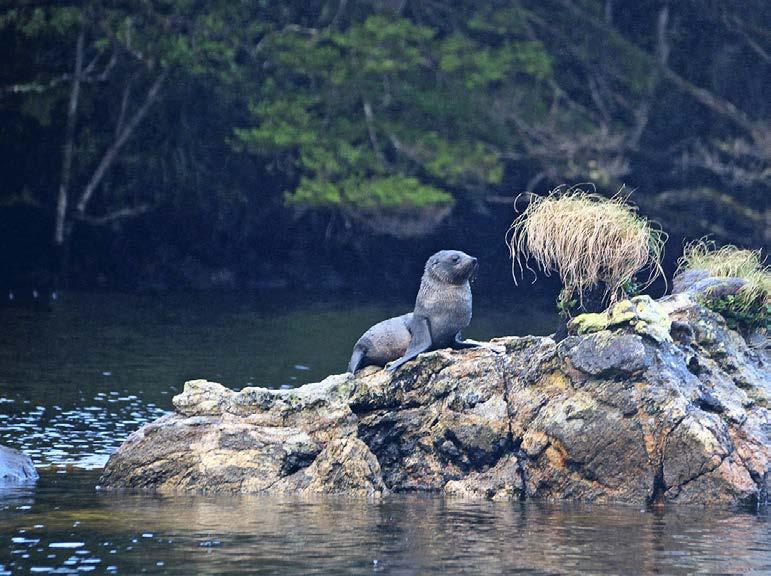
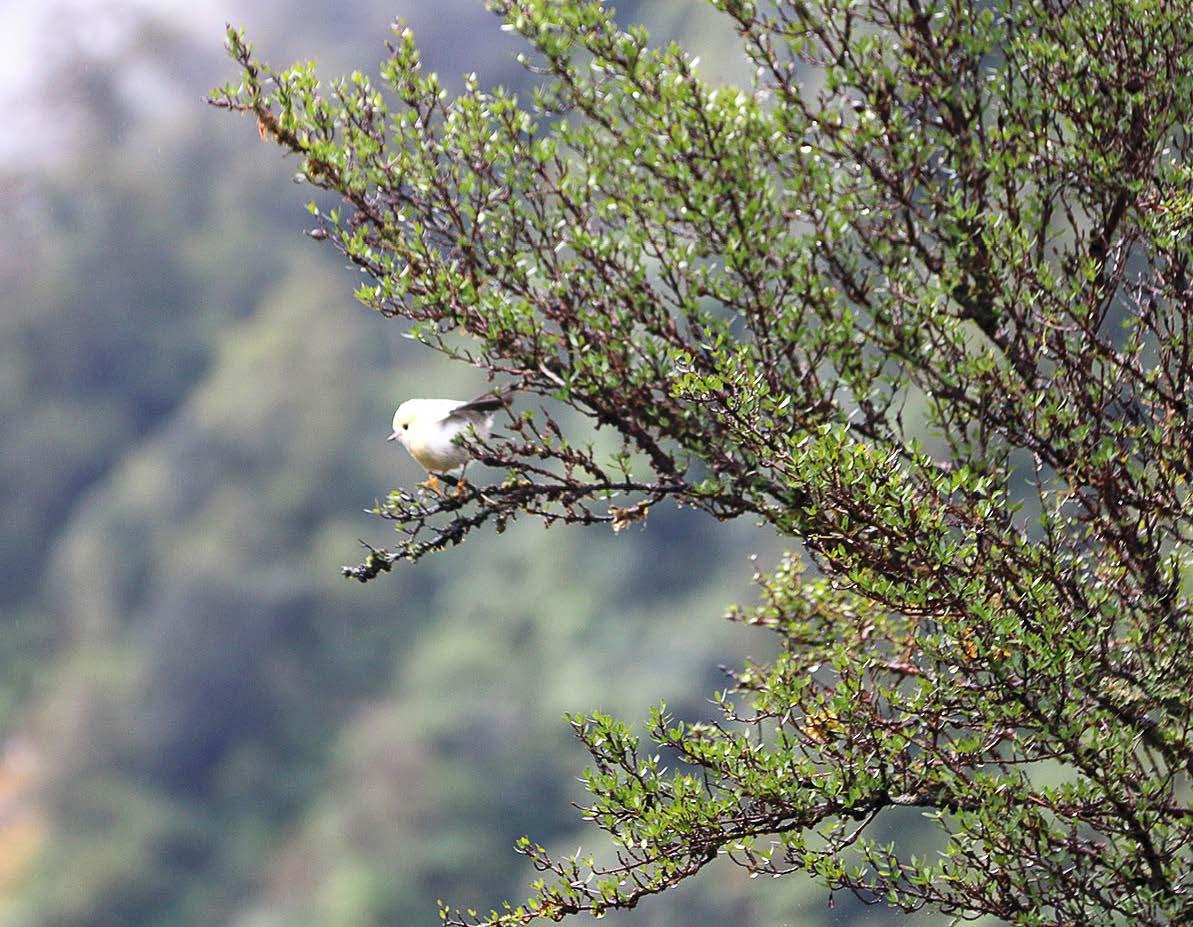

After a delicious lunch back on the boat there was just enough time to cheerfully don our now very wet wet weather gear and visit the abandoned Tarawera silver mine and smelter. A lone seal pup greeted us on landing, showing no sign of being afraid of the interlopers visiting his nursery.
After a short hill climb over gnarly tree roots, we came across an unusual brick chimney which followed the incline of the hillside rather than a normal vertical stack.
Two attempts were made to mine the lode here, one in 1897 and the second in 1907, but despite initial promise, both ventures failed. One of the surprising discoveries on this trip was just how much human activity had occurred in Fiordland since Māori
arrived more than 900 years ago. Although recreation, conservation and cray fishing are now the main occupations, during our after dinner talks each evening, we learned of pa sites, mining towns, forestry ventures, whaling stations and sealing operations.
As we left the sheltered waters of Preservation Inlet for Chalky Inlet and Great Island the following day, we had our first of several encounters with bottlenose dolphins racing beneath the bow of the Explorer. Their speed, agility and playfulness was enchanting, and several phones (and even some people) were nearly lost overboard trying to snap the perfect shot. We visited North Port, the final resting place of the rusting hulk of the GSS Stella a schoonerrigged steamship which was bought by the New Zealand government in 1876. It was used to transport supplies to the keepers stationed at lighthouses around the coast and the hull is remarkably well-preserved, although a satellite dish tied to a railing looked like a more recent addition. We saw a few of these satellite dishes in odd places throughout our journey and were told they belonged to the lobster or cray fishermen who work in these waters. Although the sounds are off limits to commercial fishing of any kind, they provide a safe haven for the storage of cray pots and live catches, which end up in restaurants mainly in China and South East Asia.
As we left the sheltered waters of Preservation Inlet and headed north to Tamatea/ Dusky Sound, the largest body of water in Fiordland, we witnessed massive waves hurling themselves against the rocks and cliff faces, sending explosive plumes of water into the air. As I’ve always been a good sailor, I smugly declined the sea sickness tablets
that were made freely available. However, the Great Southern Ocean and Tasman Sea conjured up a monotonous ocean swell, which proved too much for my tummy. I retreated to my cabin to sleep away the threehour voyage, trying to avoid any thought of food that might inadvertently lead me to the bathroom. Although we all made it to dinner that night, there were more than a few pasty faces.
It was dark by the time we dropped anchor in the sheltered waters of Cascade Cove, where we were to become more familiar with Captain Cook’s 1773 voyage on the Resolution. Showing limited imagination, Cook named many of the islands in the sound – Resolution, Crayfish, Indian (where he first encountered Māori), Cormorant and Pigeon, to name just a few. My fellow passengers and I were by now getting more adept at embarking and disembarking from the zodiacs, and we set off to visit the site where Cook and his crew set up camp after their gruelling voyage searching for the Great South Continent. When Resolution arrived in Dusky Sound, a reconnaissance led by Lieutenant Pickersgill identified sheltered waters in what is now called Pickersgill Harbour. It was hard to imagine the three masted sloop in this small waterway, tied securely to trees on either side. But here they spent five weeks resting and making repairs to the ship. A forge was set up for iron work, tents for sail makers and a workshop for the cooper (barrel maker). Cook also arranged for beer to be brewed using rimu and manuka leaves. Rum rations were postponed so the crew would drink the beer, as it was hoped it would aid in the prevention of scurvy. A source of
One of the surprising discoveries on this trip was just how much human activity had occurred in Fiordland since Māori arrived more than 900 years ago.


freshwater was close at hand, with plenty of fresh fish and crayfish to dine on. After the deprivations of the Antarctic voyage, the shelter and availability of fresh food and water must have seemed like mana from heaven. Although nothing remains of the camp, there was still a sense that we were walking in Cook’s footsteps.
Before departing, we made the short trek to nearby Astronomer’s Point, the site of a temporary observatory set up by William Wales, of the Board of Longitude, who was travelling with Cook to test the accuracy of a copy of John Harrison’s chronometer H4. As a consequence of the observations made by Wales at this point, New Zealand became the most accurately located place in the world at that time.
The Department of Conservation is involved in an ambitious restoration plan in Dusky Sound with the goal of eradicating pests, re-introducing missing species and filling biodiversity information gaps in the area. The project area includes Te Puaitaha/ Breaksea Sound, Acheron Passage, Wet Jacket Arm and Dusky Sound itself, which has more than 700 islands including Resolution Island – New Zealand’s seventh largest island. The vision is for Dusky Sound to be one of the most intact ecosystems on Earth, as well as New Zealand’s largest ‘bio bank’ – a source of endangered native species that can be sent to pest free locations throughout the country.
We awoke the next morning to an iconic Fiordland scene – Jamie, our skipper, had manoeuvred the Explorer into a narrow branch of the fiord where we were sandwiched between mountainsides rising from the dark depths of the fiords to the sky, with waterfalls weeping from rock crevices and forests woven together by mist and imagination. Our boat, our travels and even our very existence seemed insignificant compared to the timeless grandeur we found ourselves observing. It felt as if the
mountains themselves had granted us the privilege of sharing the dawn with them. The walk to Moose Lake later in the morning took us through a wonderland that would not have been out of place on the set of Lord of the Rings. I would not have been surprised in the least if we had stumbled across Gandalf smoking a pipe under one of the many ancient trees, festooned with moss and ferns. We meandered through this fairyland accompanied by the music of a nearby creek, stopping to identify bird calls which became more plentiful as we neared the lake. The ground underfoot was spongy in many places, boggy in others, and several walkers found their boots trapped in the mud. But the effort was worth the prize of reaching the tarn and viewing the serenity of a landscape just as nature had intended it to be. The slender body of water was home to ducks but, sadly, we did not lay eyes on the hoped-for whio. Nor did we see any of the phantom moose, which some people believe still wander through the forests of Fiordland, after being brought here from Canada in the early 1900s. We were rewarded, however, with a visit from a leucistic/white tomtit/miromiro, which we were told had been at the site on and off for about a year. He was a friendly little fellow, darting from ground to branch around us, and chirping his greetings.
By afternoon we were anchored off the Camelot River, which had been timed to catch the tide. Again we boarded the zodiacs to meander up the river that has its headwaters on a saddle between the sound and Te Anau, a reminder that our tour was coming to an end. The zodiac skimmed over crystal clear water where we could identify the mix of freshwater and salt water. This part of the sound is a receiving environment for discharge from the tailrace of the mighty Manapouri hydroelectric power station. All too soon, we were making our way to the
wharf at Deep Cove where a bus would take us over Wilmot Pass to the West Arm visitors centre, beside the power station. From there it was a short boat and bus trip back to Te Anau. Although we hadn’t seen moa or Haast eagles, or a kakapo or kiwi for that matter, we did sense their presence. Majestic Fiordland reminds us of just how magnificent Aotearoa must have been in a time not so long ago – every two-legged kiwi should make the pilgrimage at least once in their life.
A massive thank you to Heritage Expeditions, the Heritage Explorer crew and my fellow expeditioners for the trip of a lifetime.
Undiscovered Dusky Sound, Trip. 26-30 January 2025. Twin share, 1 x Salvin’s twin Cabin: Value: $10,790
Hibiscus Matters is excited to offer our readers the chance to win a 5-day voyage for two on Heritage Expeditions Undiscovered Dusky Sound voyage.


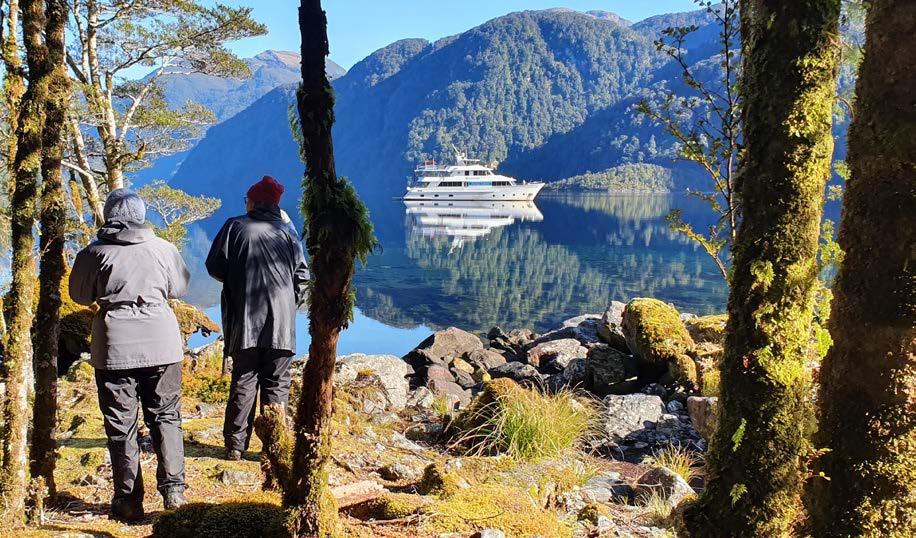


After another ocean stretch, we reached Patea/Doubtful Sound and the next morning we did a short walk on Secretary Island, one of the few islands never to have been infested with rats and mice. An inquisitive weka joined us as we beachcombed along the stony shoreline, but a wine bottle of a recent vintage was about all that we discovered. Thankfully, we came across next to no litter on any of the beaches we visited. Next there was a chance to kayak or do a zodiac tour, and we got to see Fiordland’s version of Queenstown’s The Blanket Hotel. BOOK NOW & SAVE UP TO 20%* Freephone 0800 262 8873 info@heritage-expeditions.com www.heritage-expeditions.com
Set sail on the voyage a lifetime with New Zealand’s pioneering expedition cruise company Heritage Expeditions and benefit from our 40 years of exploring the New Zealand coastline. Discover the primordial majesty of Fiordland on an unforgettable 5-day voyage cruising Acheron Passage, Breaksea and Dusky Sounds. Starting and concluding with a thrilling, scenic helicopter flight between Te Anau and Supper Cove, you will explore the sheltered waters, hidden coves, islands and astounding scenery of World Heritage Area Dusky Sound, one of Fiordland’s largest fiords some 40-kilometres long and studded with more than 350 islands. Only accessible by sea, Dusky Sound is among the most isolated areas on New Zealand’s mainland. We’ll also explore Acheron Passage and Breaksea Sound with opportunities to explore on foot, by Zodiac and kayak. Bask in the towering fiords, abundant birdlife and rich history of one of New Zealand’s best-kept secrets. Travel is aboard our 18-guest expedition yacht Heritage Explorer where luxurious en-suite staterooms meet meticulously crafted itineraries led by expert guides and all-inclusive gourmet dining with house wine, beer and soft drinks, all inclusive excursions and use of on board kayaks and fishing equipment.
To enter: scan the QR code, visit www.heritage-expeditions.com/matters/ or drop or post your entry to Hibiscus Matters, 21 Florence Ave, Ōrewa 0931, and tell us in 25 words or less why you want to join Heritage Expeditions Undiscovered Dusky Sound voyage. T&Cs apply, please visit www.heritage-expeditions.com/matters/ to read the full terms and conditions before entering.
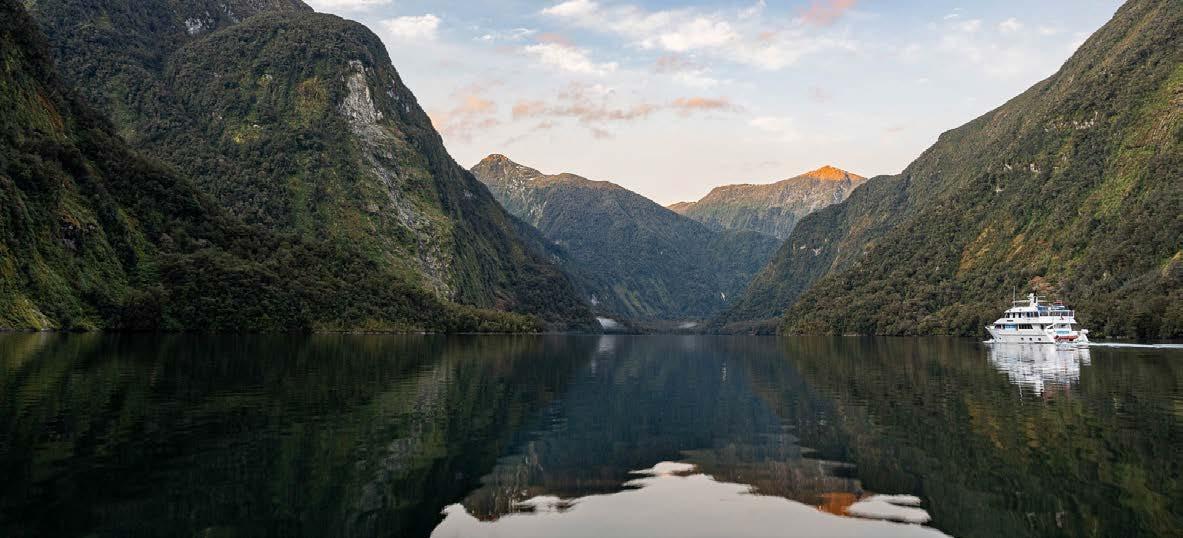

Heritage Expeditions have been sharing the wilds of New Zealand with like-minded guests for more than 40 years and invite you on the voyage of a lifetime. Explore Fiordland’s world famous Acheron Passage and Breaksea, Dusky and Doubtful Sounds; the tranquil waterways of historic Queen Charlotte and Pelorus Sounds, French Pass and d’Urville Island; and Stewart and Ulva Islands, Paterson Inlet, Kaipipi Bay, Port Pegasus and Lords River – all only accessible by sea. Join us for an unforgettable, intimate exploration of some of Aotearoa’s most remote, and iconic, locations aboard our 18-guest expedition yacht and by Zodiac, kayak and on foot with New Zealand’s own expedition cruise pioneers. JOIN NEW ZEALAND EXPEDITION

FIORDLAND | 5-10 days
From $5,145 $4,115 per person
MARLBOROUGH SOUNDS | 5-9 days
From $4,490 $3,590 per person
STEWART ISLAND | 8 Days
From $7,695 $6,155 per person
• Scenic helicopter transfer^
• All on board accommodation & meals
• House wine, beer & soft drinks
• All shore excursions
• Experienced expedition team
• Kayaks & fishing equipment available
• Transfers to and from Heritage Explorer
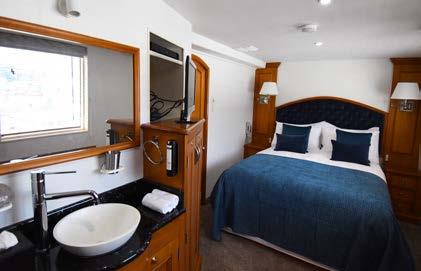
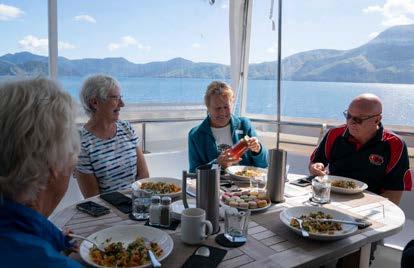
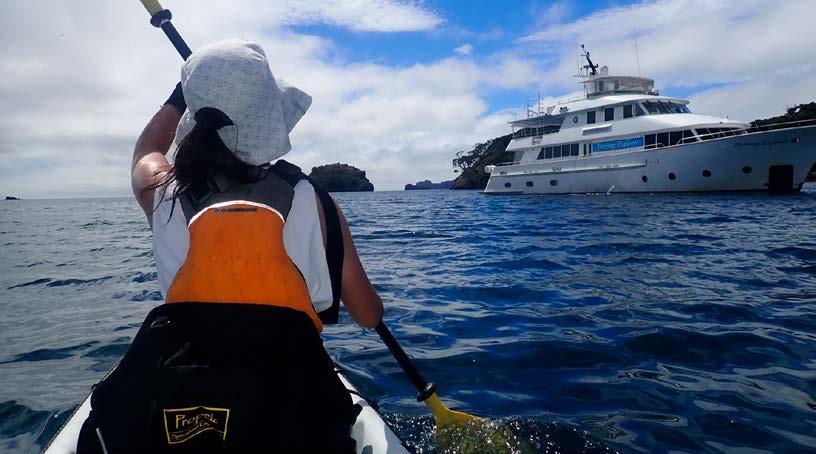





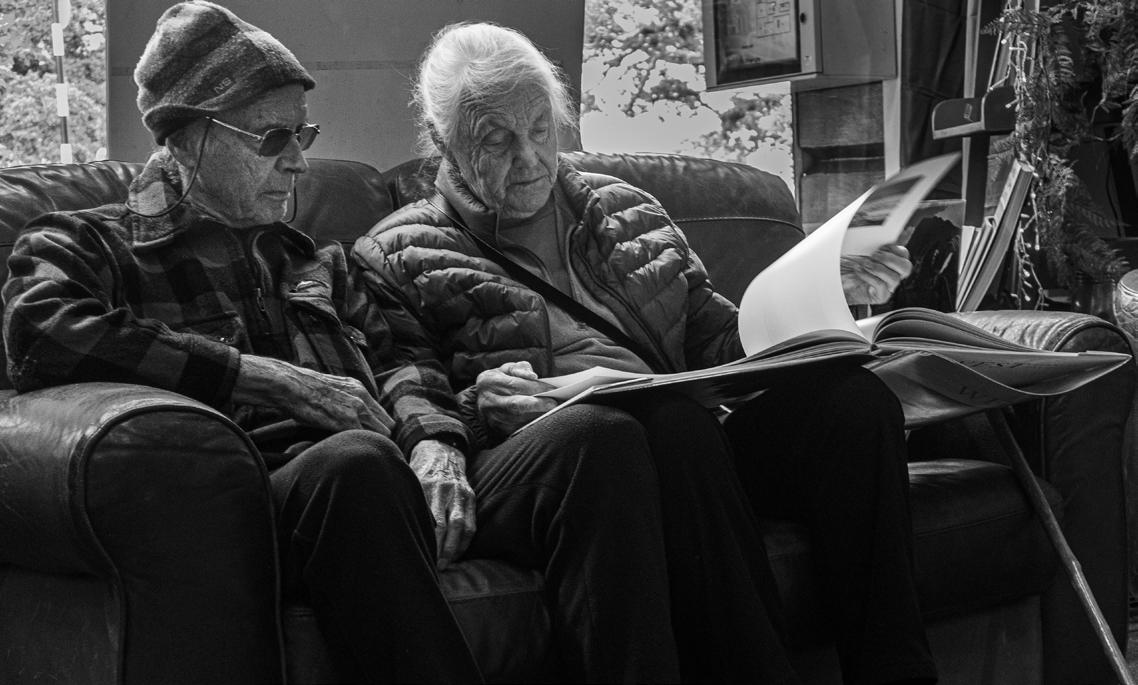
On a recent visit to Devonport I came across a couple browsing large, old books. The book in this photo had personal meaning to them. It appeared to be about the West Coast and seemed to bring back a few memories. As they leafed through the pages I was able to capture this image. The low angle added to the character of the couple, and helps create the atmosphere.

Book Review: Think Twice by Harlen
Coben
It’s been eight years since Coben last wrote about sports agent Myron Bolitar and fans will find it interesting to see how his life has moved on. Bolitar delivered a eulogy at a client’s funeral some years ago, but strangely this person’s DNA has been found at a recent murder scene. So how can a man who’s already dead be wanted for murder? The FBI is involved, and the time for answers is running out. Readers unfamiliar with Bolitar will soon pick up on the way he operates. As the book progresses, suspects multiply, friendships become strained and family members close ranks until it all becomes a murky and murderous conspiracy. Twists and turns abound, with an ending both gruesome and final. This murder mystery is a relaxing read because it can be put down and returned to without losing a beat, as the storyline is regularly re-explained. Reviewed by Barbara Leslie






Young artists are taking over Silverdale Mall this month. For four weeks, the mall has turned its hallways into a gallery showcasing artwork by local students invited to “Portray Your Idea of Community”.
Capturing the essence of the Hibiscus Coast, the inspiring collection features original works from students at Ahutoetoe Primary School, Kingsway Primary School, and Stella Maris Catholic Primary School. “I feel proud that my art is on display at Silverdale mall,” shares Haleema, Ahutoetoe Primary artist.
Students were invited to express their idea of community by capturing landmark buildings, the estuary, stunning beaches, and the diverse flora and fauna. The inaugural Mini Artists’ Exhibition opened
on the first day of the school holidays, and that’s where five-year-old Ella was spotted proudly showing off her creation to her dad. “We are a community mall so it was important to involve the next generation of our community,” said Elderie McDonald, Administration Manager. From Year 1s through to Year 6s, young artists used various mediums from pen and paper to crayon and paint, to bring their creations to life. Ahutoetoe primary artist Arihitha declares, “Art is my favourite subject. I particularly enjoyed the collage.” Next year, McDonald hopes to include more schools in the exhibition.
Don’t miss the opportunity to see our world through the eyes of the next generation. The exhibition runs until Sunday, 27 October 2024.





Enquiries over $640,000^
Affordable two bedroom apartments available now.
If you’re looking for a retirement village that feels like a village, not a retirement city, come and visit us at Bupa Northhaven. Our apartments are modern, light, and spacious, creating a comfortable, functional home that looks great and is a pleasure to live in. Embrace the lock up and leave lifestyle that apartment living offers.

• Fixed weekly fees
• Well designed, modern kitchen
• 24 hour emergency call system
• Care home located on site (subject to availability).
Contact Jo on 09 971 1506 or visit bupa.co.nz/northhaven for more information.
Bupa Northhaven Retirement Village 142 Whangaparāoa Road, Red Beach
^Price is for a licence to occupy under an Occupation Right Agreement.
Lauraine Jacobs www.laurainejacobs.co.nz/blog/
Whether it’s a cocktail party, morning tea, finger luncheon or just a simple gathering of friends over a cuppa, you can’t go wrong with a sandwich. If the call goes out for the good old Kiwi ‘bring a plate’, it’s a sure bet that freshly made sandwiches will go down a treat and be the first platter to be cleaned up. Everybody loves a really good sandwich – something I wish cafés would cotton on to. How often do you go to a café and are daunted by the humongous size of the food in the cabinet, when all you want is just a small bite to go with your morning coffee?
Perhaps of all the things I ever prepared for my mother, to tempt her to eat in her final years, asparagus rolls were her favourite. When new season’s asparagus arrived in the stores, I would prepare about eight dainty little rolls and take them to her and her friend in the next room at the care home, and they would adore them. Easy to eat in the fingers and always delicious.
A classic New Zealand treat, asparagus rolls are usually made with tinned asparagus, but are superb when made with the abundant fresh asparagus currently in season. If you’re making asparagus rolls ahead, cover them with plastic wrap and then put a very damp clean tea towel round them. They will stay moist for up to six hours.
The other sure-to-please is a good old ham and egg club sandwich. This may be the best ham and egg sandwich you have ever had; white or wholemeal bread, layered with good ham and mustard, and the other half, a delicious savoury egg mixture. You can cut them as shown into a dainty size, or into more chunky rectangles. But if making any sandwiches ahead, be sure to keep them moist with damp paper towels and tightly covered cling film wrap.
Note: There are 21 slices of bread (excluding crusts) in a sandwich cut loaf. If you can find it, the Oatilicious bread is my favourite as it has more body and flavour than the standard white sliced loaf.

½ cup mayonnaise (I like to use
Best Foods brand)
6 free range eggs
1 tsp mustard powder
Salt and freshly ground black pepper
4 tbsp finely chopped fresh parsley
300g shaved or sliced free range ham
2 tbsp Dijon mustard
Make the egg filling by plunging the eggs into rapidly boiling water to cook for 8 minutes. Immediately remove and plunge into icy cold water to cool rapidly.
Peel the eggs and place in a bowl.
Use a potato masher to crush the eggs and add the mustard powder, salt and pepper, 4-5 tablespoons of mayonnaise and the parsley. Mix well so the eggs are well mashed and
20 thick spears fresh asparagus
20 slices of white or wholemeal ‘sandwich cut’ bread
½ cup mayonnaise (home-made or Best brand)
Salt and freshly ground black pepper
1 lemon, finely grated zest only
the heat and bring to the boil. Trim and peel the stalky ends of asparagus, and plunge the spears into the boiling water. Allow to simmer for three minutes, then remove from the heat and drain under gently running cold water so the asparagus cools rapidly

not too chunky.
Divide the egg in to seven portions and spread over seven pieces of the bread. Top each with a second slice. Lightly spread the upper side of these pieces of bread with Dijon mustard and then divide the ham into seven portions and place them on the mustard spread bread.
Finally spread the remaining seven slices of bread with mayonnaise and press lightly onto the ham.
Take a very sharp knife and cut the crusts off each side of each sandwich. Cut each sandwich into three fingers or four squares and line them up on a sandwich plate. Cover with cling film wrap and then with a wet tea towel until ready to serve. Makes 21 sandwiches.
and retains the bright green colour. Cut the crusts from each slice of bread with a very sharp knife so you get a clean edge. Spread each slice generously with the mayonnaise. Sprinkle plenty of salt and pepper over the mayonnaise. Grate the lemon zest on top and place a spear of asparagus in the centre of the bread slices. Roll up each slice around the asparagus. To finish you can either lay these asparagus rolls on a sandwich plate, or if you’d like them to be a bit more delicate and bite-sized, you can cut each roll into half. Makes 20 or 40 rolls.

2:06am0.3 8:31am3.5 2:30pm0.3 8:53pm3.5 2:57am0.2 9:22am3.5 3:20pm0.3 9:44pm3.5 3:46am0.2 10:11am3.6 4:10pm0.3 10:35pm3.4 4:35am0.2 11:01am3.5 5:01pm0.5 11:26pm3.3 5:24am0.3 11:51am3.4 5:55pm0.6 12:18am3.2 6:14am0.5 12:43pm3.2 6:51pm0.8 1:11am3.0 7:07am0.7 1:39pm3.1 7:51pm0.9 2:07am2.9 8:04am0.9 2:38pm2.9 8:53pm1.0 3:05am2.7 9:07am1.0 3:38pm2.8 9:54pm1.0 4:06am2.7


Locals have long-awaited progress on the sports facility planned for Millwater’s Metro Park. With two competing bids for the space, the local board will have to assess the two proposals against what is best for the community, and the facilities offered.
For one of these proposals, the “Y” has commissioned Harbour Sport, an independent organization with a broad understanding of community activity, to collect accurate and meaningful input from all sectors of the community, beyond just the sport sector.
Their first step is a public needs analysis starting with online surveys, followed by a series of workshops. Based on data from this consultation, “The Y” will integrate community needs and aspirations into their planning and proposal.
Given the project’s complexity and cost, the “Y” says its essential to design a multiuse facility that maximizes utility and benefits for all. After the consultation concludes, the “Y” will make a decision on proceeding and engage in the necessary council procedures.
The survey launch has already caused a stir online with locals passionate about what goes in their backyard. Have your say before the surveys close on October 15.
This consultation is open to individuals, families, community members, organizations, clubs, local groups, schools, and Regional Sports Organizations (RSOs). General Public Survey: https:// forms.office.com/r/puaVNKDTLv Organisation Specifc Survey: https://forms. office.com/r/xaXsv77mTy
Skin is the largest organ in our body, and it functions as a barrier protecting us from environmental threats and retaining moisture. When our skin barrier is intact and functions properly, it keeps irritants and pathogens out, heals damaged cells from UV rays and maintains hydration. However, a compromised barrier can lead to slower wound healing, increased risk of skin cancer, and other skin issues.
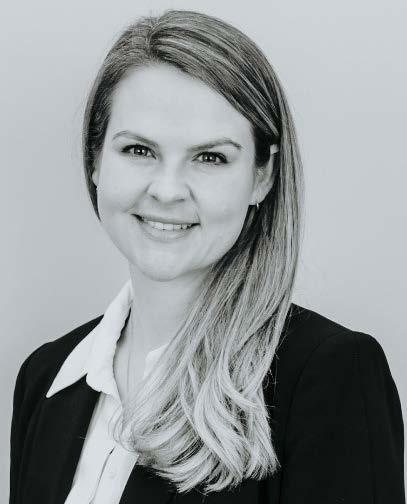
As we age, particularly during menopause for woman, and after a life-time of UV sun exposure, our skin undergoes significant changes. Skin often becomes thinner, drier, and more prone to damage. These changes can impair the skin barrier, making it crucial to pay attention to signs of damage. Look for red, scaly patches, persistent sores, or signs of irritation like eczema, acne, or rosacea. Irregular pigmentation and itchy, dry skin are also common indicators of a weakened barrier. If you notice any of these symptoms, it’s important to have it checked and receive advice on how to improve your skin barrier and reduce your risk of developing skin cancers.
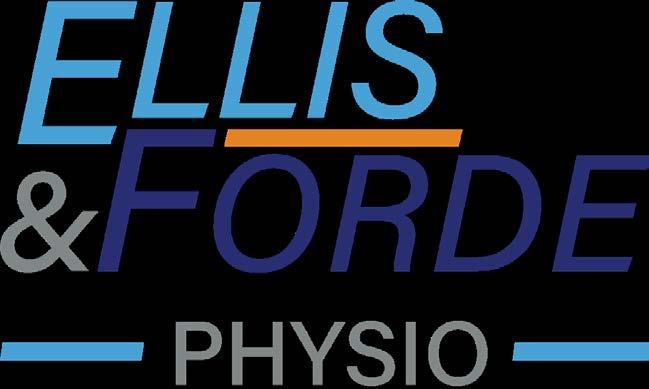
Your journey to wellness is guided by hands that heal and care, offering those seeking respite from pain and movement limitations. We believe in the power of personalised care tailored to your unique needs. Whether you’re recovering from an injury, managing chronic pain, or striving to improve your athletic performance, we’re here to support you every step of the way. Join us, and experience the difference, where every treatment is a step towards a better, more active you.







Ellis and Forde Physio Orewa | Monday-Friday: 7.20am-6pm 39a Florence Ave, Orewa | phone 09 421 0074 or book online: www.ellisandfordephysio.co.nz
A balanced diet rich in vitamins and antioxidants supports skin health from within. Additionally, daily use of broad-spectrum sunscreen with SPF 30 or higher protects your skin from UV damage, which is particularly important as our skin becomes more sensitive with age. A consistent skincare routine also plays a vital role. Choose gentle, hydrating products that support the skin’s natural barrier and avoid harsh cleansers that can strip essential oils. At SkinSafe we offer affordable but effective skin care ranges, and we can help find which products would best suit your skin. Regular skin checks are also important to detect and treat pre-cancerous lesions as well as skin cancers early for the best outcome.
If you are experiencing any signs of skin barrier damage or have concerns about possible signs of skin cancer, don’t hesitate to visit us at SkinSafe. Our team are here to help you maintain healthy, resilient skin.
Dr. Rianda De Roe
BSLP MBChB FRNZCGP ACCSCMS DipCM

Mon-Fri 8.30am-5pm | 18 Florence Ave, Ōrewa Clinic: 09 242 7546 | support@skinsafe.co.nz skinsafe.co.nz






















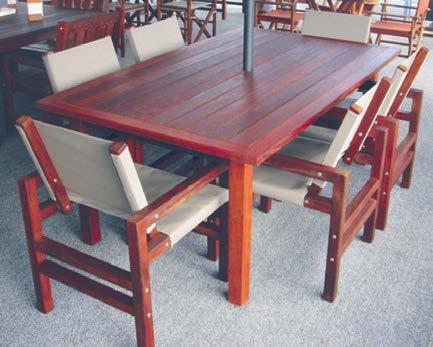











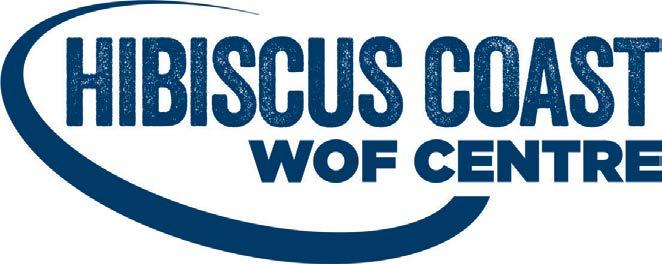

















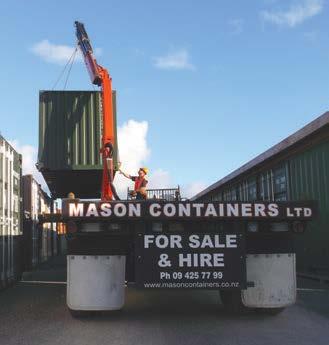

















A SMART REPAIR Service for F&P smartdrive washers, F&P/Simpson dryers. Prompt service ph 021 168 7349.
VIDEOS TRANSFERRED to DVD/hard drive. Ph/txt Te Totara Video 021 777 385.
WANTED TO
TO BUY, RECORDS/LP’S 09 428 1587 txt 0210 258 3437












ALARMS SECURITY AND FIRE, MONITORING, CCTV, servicing & installation, all brands 027 553 3032 www.tdssecurity.co.nz
CARPET LAYING, CARPET RE-STRETCH, VINYL LAYING, CARPET REPAIRS Over 30 years’ experience. Contact Dexter 027 4956 436
HOUSE WASHING - SOFT WASH / LOW PRESSURE / CHEMICAL WASH Also Window Cleaning / Gutter Clearing / Decks / Concrete. Careful service, reasonable rates. qualitywash.co.nz / 021 0579743
PUMP DOCTOR
WATER PUMP & FILTER SERVICES. New installs for all your water pump requirements. Ph 0274 430
ARKLES BAY PAINTERS/DECORATORS In the area for the area. Shane 021 0813 8481. CARPET ADVICE, FREE QUOTE FOR STEAM CLEANS, Carpet Repairs, 35 years experience Dwayne 027 499 7929. ELECTRICAL WORK Installation/upgrade of switch boards, down lights, power points, ceiling fans, ovens and hobs. Spa power, EV charger power. All small jobs welcome. Ronnic Electrical Ltd 021 752 430 PEST CONTROL Eradication of rats & mice. Competitive Rates. Ph 426 2253 Ph 027 286 7321, www.noratsandmice.nz
and blow wave services. Please phone Julie 021 112 8015
exp Owner Operator 30 years. Single Items to Flat/House lots. Silverdale Based. Ph Gavin 0274 973 867
Lose weight. stop smoking. anxiety and depression, confidence, self esteem. Ph 021 635 966 www.hypnotherapy2succeed.co.nz
COAST RAIDERS Rugby League & Sports Club (Inc.) AGM, Clubrooms, Brightside Rd, Stanmore Bay. 6.30pm, Tuesday November 12. Nomination forms for Executive Committee positions can be obtained from the secretary hbcraidersrlsc@ gmail.com Notices of motion and nominations close 5pm, November 4.
HIBISCUS COAST 500 CARDS Meet
Mondays 6.30pm-9pm. Entry fee $7. Beginners welcome. Contact Peter, ph 021 704 440, email strudwickp@xtra.co.nz
HIBISCUS COAST CLOTHES SWAP
Saturday 9th November 2pm, Paraoa Brewing - 713 Whangaparāoa Road. Register and find out more detail - www. hibiscuscoastzerowaste.co.nz
HIBISCUS COAST RAIDERS Rugby League & Sports Club (Inc.) AGM, Clubrooms, Brightside Rd, Stanmore Bay. 6.30pm, Tuesday November 12. Nomination forms for Executive Committee positions can be obtained from the secretary hbcraidersrlsc@gmail. com Notices of motion and nominations close 5pm, November 4.
HIBISCUS COAST FRIENDSHIP CLUB, Meet at the Bridge Club, Edith Hopper Park, Manly, 4th Wednesday of the month, 10am for talks and coffee. We enjoy meetings, movies, outings and luncheons. Join us phone Peter or Jeanne 426 8675.
NATIONAL COUNCIL OF WOMEN – Hibiscus Coast, $2,000 TERTIARY STUDENT AWARD – 2025 Applications are now open to a past or present female Hibiscus Coast resident. Application Forms & Criteria available by email to: davenjen@xtra.co.nz Applications close December 31st 2024.

THE PICKERS – Have you got an abundance of fruits, veggies, or flowers in your garden and hate seeing them go to waste? We will collect, redistribute, and repurpose your produce into the community at no cost. Info: www.ripple.net. nz/the-pickers or ph 027 647 5000.
REPAIR CAFE – Want to volunteer? Volunteers fixing household items for free (donations welcome). Ōrewa Repair Cafe, 11am-2pm, Ōrewa Community Centre, 40/46 Ōrewa Square. Nov 2, Dec 7 and onwards as above at Ōrewa Community Centre. Info contact: coordinator@ hibiscuscoastzerowaste.co.nz
ACROSS: 1 Drive a hard bargain, 10 Thoughts, 15 Clowns, 16 Postscript, 17 Tribunal, 19 Declare, 21 Litre, 22 Inaudible, 25 Violinist, 27 Brittle, 29 Intone, 33 Juice, 34 Concerns, 36 Comprehend, 39 Odd, 41 Leaning, 42 Manual, 43 Aviary, 44 Join, 45 Immense, 48 Meddlesome, 53 Spectre, 57 Kirk, 58 Thanks, 59 Garish, 60 Retract, 62 Keg, 64 Dog biscuit, 65 Aquarium, 66 Eaves, 69 Pullet, 70 Another, 71 Agreement, 76 Rationale, 77 Dummy, 78 Stadium, 83 Chuckled, 84 Strawberry, 85 Ceylon, 86 Amputate, 87 Golden opportunity. DOWN: 2 Rolled, 3 Vowel, 4 Ass, 5 Alps, 6 Dismiss, 7 Absorb, 8 Girl, 9 Impunity, 11 Hermit, 12 Unbalanced, 13 Hind, 14 Salvage, 18 Guillotine, 20 Rule, 23 Ingot, 24 Foremost, 26 Incense, 28 Resolve, 30 Museum, 31 Around, 32 Spares, 35 Crate, 37 Dense, 38 Ends, 40 Dado, 45 Irked, 46 Marigold, 47 Ethics, 48 Mentioning, 49 Desk, 50 Luggage, 51 Sprout, 52 Miser, 54 Pier, 55 Certain, 56 Riches, 61 Lifejacket, 63 Buyer, 67 Stiletto, 68 Omit, 69 Panacea, 72 Gumdrop, 73 Silent, 74 Turban, 75 Dugout, 79 Doyen, 80 Jump, 81 Hand, 82 Typo, 85 Cot.
10 The A to Z of Successful Fishing in the Hauraki Gulf with Bruce Duncan, well known for his fishing abilities through his books and videos. Sponsored by Hunting & Fishing, join us @ Gulf Harbour Yacht Club, near the GH Ferry. Light meals available from 6pm, talk starts at 7pm. Everyone welcome, $5 entry for non-members.
12 Stevie Nicks Xperience, Parāoa Brewing Co, 719A Whangaparāoa Road, Whangaparāoa. 8pm-11pm. Tickets: www.eventfinda.co.nz/2024/stevie-nicksxperience/auckland/whangaparaoa-peninsula
12 Legacy Pro Wrestling Carnival of Horrors, Ōrewa Community Centre, 40/46 Ōrewa Square, Ōrewa. 6.30pm-9pm. Info and tickets: www.eventfinda. co.nz/2024/legacy-pro-wrestling-carnival-of-horrors/auckland/orewa
12 & 13 Model Train Show, Whangaparāoa Hall, Corner Whangaparāoa Road and Main Street. 10am-4pm. Organised by the Auckland Marklin Club.
15 Food Scraps Collection Service, Whangaparāoa Library, 11am. How and why to use your food scraps collection bin. Free event.
15 Baby Loss Awareness – Wave of Light Ceremony, The Settlers Cottage at Auckland Memorial Park & Cemetery, Stillwater, 6.30pm. For people affected by baby loss - parents, grandparents, family and friends. Candle lighting followed by refreshments. RSVP: kellytownsend.celebrant@gmail.com
16 A Superyacht Cruise Through the Mediterranean with Mike Pignéguy, Whangaparāoa Library, 10.30am. Come along on a virtual cruise of the coasts of Italy and Greece with Maritime adventurer, Mike Pignéguy. Free event.
16 Hibiscus Coast Forest and Bird presents a talk by DOC senior ranger Adeline Bosman about the essential role of dogs in biosecurity. Estuary Arts Centre, Western Reserve, Ōrewa, 7pm. Info and updates: www.facebook.com/ hbcforestandbird
18 CYC Trust Golf Fundraiser - Sponsored by Woolworths Whangaparāoa, 9am7pm Whangaparāoa, 1337 Whangaparāoa Road, Army Bay, Whangaparāoa. For info and to register: www.cyctrust.org.nz/event-details/cyc-trust-golffundraiser-sponsored-by-woolworths-whangaparaoa
19 Dining for a Difference, hosted by Coast Community Trust, Ōrewa College Arts & Events Centre, Florence Ave, Ōrewa, 6pm to 10pm. Community dinner and auction for charity – food, fun, and philanthropy. Guests will enjoy culinary delights, live entertainment, and silent and live auctions. Tickets: www.eventbrite.com/e/dining-for-a-difference-2024-tickets-952409501457 Info: coastcommunity.org.nz
19 Silverdale School Country Show Day, Longmore Lane, Millwater, 10am-2pm. Entertainment, stalls, silent auction, raffles and more. Fun for the whole family.
19 Dairy Flat School Ag Day, 1220 Dairy Flat Highway, 8.30am-1pm. Farm animals, games, pony rides, market, raffles, food court, cake stall, art displays and more
20 Death Café, Whangaparāoa Library, 10.30am. Conversations about grief, death and dying over cake and coffee – final event of the year. Entry free.


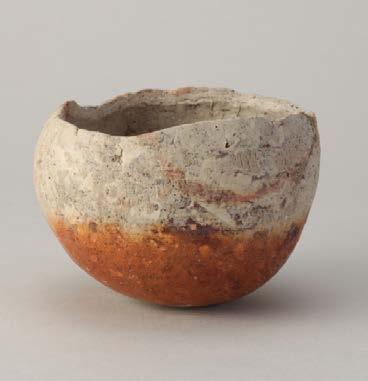


We’re living a lot longer than ever before, so we need to make sure our skeletons last! One in 3 females and one in 5 males will suffer an osteoporotic fracture in their lifetime. So how strong are your bones and what can you do to make sure they last the distance?
Bone is a dynamic tissue that is constantly being remodelled. We reach maximum bone density and strength by the time we are 30. As we continue to age our bone mass begins to decline, so the risk of bone fractures increases exponentially with age.
Osteoporosis is a condition where a person has low bone mass and deterioration in the structure of the bone tissue. It causes such a loss of bone strength that even a slight bump or fall can lead to a broken bone. It is often referred to as a silent disease as it has no signs or symptoms until a fracture or break occurs. The good news is that lifestyle modifications can improve bone health and there are also safe and effective treatments available.
Exercises to strengthen your bones include weight bearing aerobic exercise (eg. dance), resistance training using free weights or body weight (eg. pilates) plus exercises to improve posture, balance and body strength ( eg. tai chi)
Calcium from your diet is important. Low fat dairy is an excellent source. Non dairy sources include sardines and canned salmon, leafy greens and legumes. Calcium is best to get through your diet rather than using supplements. However if your daily calcium intake is low (500 -900mg/day), ask our pharmacists which supplement would best suit you as there are some safety concerns related to calcium supplements. You can calculate your calcium intake by keeping a food diary and adding up the amount of calcium in each food.
Vitamin D keeps your bones strong by helping your body absorb calcium. Over 30% of adults in New Zealand have low blood levels of vitamin D. It might sound a bit odd but the best way to get Vitamin D is actually from sunlight. Your body creates Vitamin D when the sun shines directly on your skin. Unfortunately, exposing your skin to the sun increases your risk of skin cancer and provides a conundrum in that our liberal use of sunscreen might be one of the reasons us kiwis are low in vitamin D. (sunscreens limit the synthesis) There are supplements available. Be sure to speak to one of our pharmacists about which supplement would best suit you and at what dose, especially if you are taking other medications.
Treatment includes prescription medications that work on the bone making cells and help restore lost bone and prevent further bone loss. These are available through your doctor after a consultation to ascertain your needs.
So are your bones healthy? There are several ways to test your bone mass to give you an indication of your bone health including assessment through your GP. Another way to assess your risk is by an ultrasound bone analysis through the heel. This type of analysis will:
• Assess your fracture risk
Measure the structure, elasticity and density of your bone
• Give an explained graphical display of your assessment
• Jeanette from Ultrascan provides heel analysis and will be visiting Unichem Manly on Thursday, 31st October. Consultations cost $48 . Book on www.unichemmanly.co.nz or call us on (09) 424-7708
As many as 3000 people, mostly children, turned out to enjoy the early spring sunshine on September 21, with 20 tonnes of snow shovelled in to add a festive touch.
Hellen Wilkins, business association manager for Destination Ōrewa Beach, said that since the ground was too wet to accommodate the trucks ferrying the snow from Snowplanet, it had to offloaded onto the footpath and verge. Members of the Hibiscus Coast Cricket Club and others brought spades and a wheelbarrow and moved it to where it needed to be.
The task took hours, as increasingly impatient, excited children waited to be allowed to climb in. Then the fun began.
“The only complaints we received were re the colour of the snow,” said Hellen.
“I think they would be from folk who have never lived around snow – to know it is pretty and white when it’s first laid or when it sits on a mountain top, but quickly picks up airborne particles, road dust, fuel pollution, sand etc and so discolours very quickly.”
The event was funded through a partnership with Harcourts Cooper & Co Millwater & Silverdale, partnership funding from the Hibiscus and Bays Local Board and funds allocated in the Destination Ōrewa Beach annual budget, she said.



